SAINT IGNATIUS AND THE JESUS TRAIL
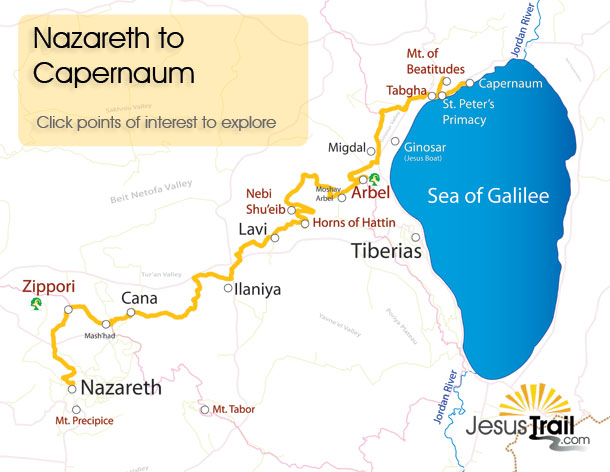
The Jesus Trail
I originally began this blog, Walking with Iñigo — the Ignatian Camino, following in the footsteps of Saint Ignatius of Loyola, when I was walking the Ignatian Camino (from Loyola in the Basque Country to Manresa in Catalonia) with a group of 20 pilgrims in September-October, 2013. My objective was to help to promote the Ignatian Camino. I have also walked other Caminos, such as the Camino Frances from St Jean Pied de Port, France to Santiago de Compostela, Spain and the MacKillop-Woods Way from Portland to Penola in Australia, a seven-day hike in the states of Victoria and South Australia which I have written about in this blog. Now I am about to embark on the Jesus Trail in Israel, and I will write about this experience over the next week.
What is the Jesus Trail?
The Jesus Trail is a 65-kilometre hiking trail in the Galilee region of Israel which connects important sites from the life of Jesus as well as other historical and religious sites. The Jesus Trail offers pilgrims the experience walking in the footsteps of Jesus.
The route begins in Nazareth and passes through Zippori National Park,Cana, Ilaniya, Kibbutz Lavi, the Horns of Hattin, Nebi Shu’eib, Arbel National Park, Migdal, the Jesus Boat at Kibbutz Ginosar, Tabgha, the Mount of Beatitudes, and Capernaum.
How do we know this is where Jesus actually walked?
Jesus spent the bulk of his life and ministry in the Galilee region, and we can be certain that he walked between the towns and villages mentioned in the New Testament. Most towns and villages from scripture have historical ruins that can be traced back to the first century, and geography often defines and limits the best ways that people would choose to travel on foot between these places.
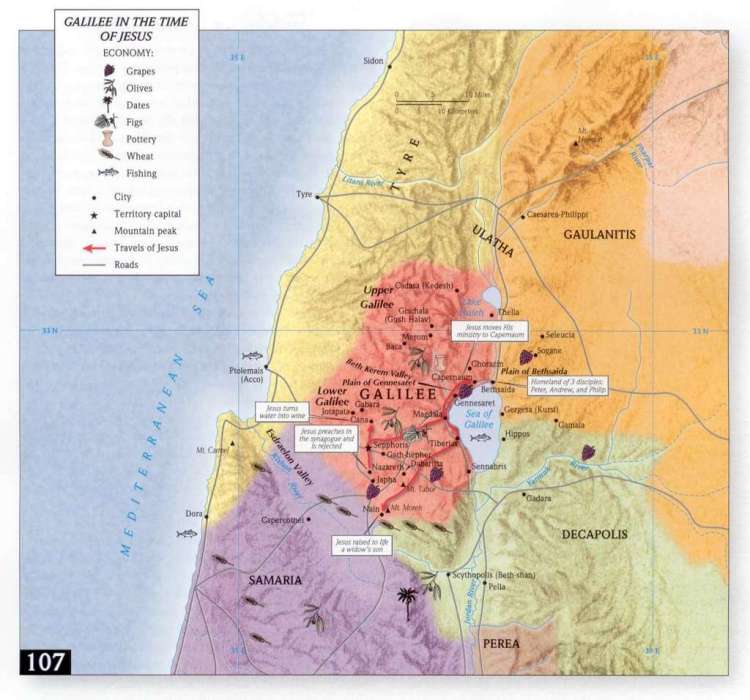
Some sections of the Jesus Trail trace paved Roman roads and other ancient paths which Jesus would have walked.

Saint Ignatius of Loyola
As this blog is named Walking with Iñigo — the Ignatian Camino,following in the footsteps of Saint Ignatius of Loyola, you might ask what the connection is with Saint Ignatius of Loyola. In fact there is a connection. Iñigo made a pilgrimage to the Holy Land in 1523, and I am following his footsteps. However, he visited Jerusalem and Bethlehem only. He did not have time to travel to Galilee because a war was about to break out and the Franciscans were anxious that all pilgrims leave. (To read Ignatius’ own account of his time in the Holy Land, which is taken from hisAutobiography, please click here to download Inigo’s pilgrimage to the Holy Land.)
He told Lius Conçalves da Camara, the Jesuit to whom he dictated hisAutobiography, that:
When he thought of going to Jerusalem barefoot and of eating nothing but plain vegetables and practicing all the rigours that he saw in the saints not only was he consoled when he had the thoughts but even after putting them aside he remained satisfied and joyful.[1]
In the spring of 1523 Iñigo López de Loyola followed his dream. He left Manresa and set out for Barcelona on his way to Rome, where he arrived on Palm Sunday. After two weeks he left Rome, having received the blessing of Pope Adrian VI to make a pilgrimage to Jerusalem. He then went to Padua and on to Venice, where he begged for his bread and slept in the Piazza di San Marco until a rich Spaniard gave him shelter and obtained an order from the Doge for a passage in a pilgrim ship bound for Cyprus, from where he could get to Jaffa. On 31st August 1523 disembarked at Jaffa.

Peter-Paul Ruben’s depiction of Ignatius boarding the ship in Venice for the Holy Land
He had, for over a year, longed to go to Jerusalem and to visit those places where Jesus had been physically present as Francis of Assisi had done before him.[2]
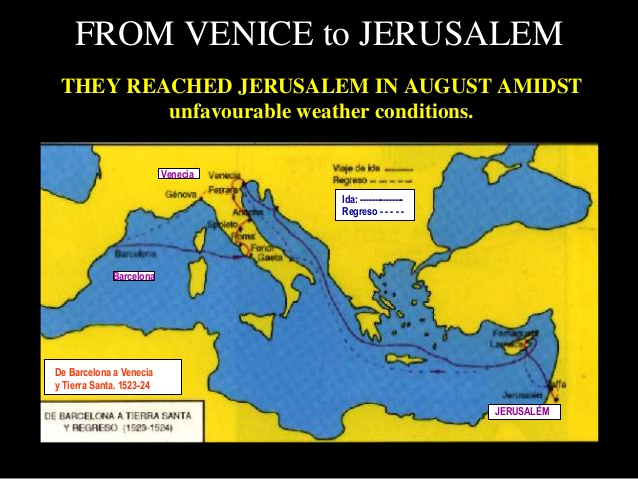
Map of Ignatius’ sea voyage to the Holy Land
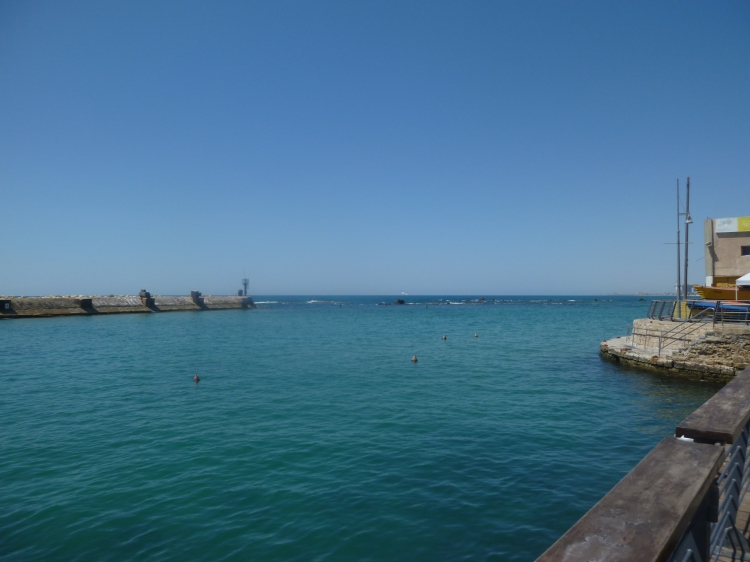
The Port of Jaffa where Ignatius desembarked
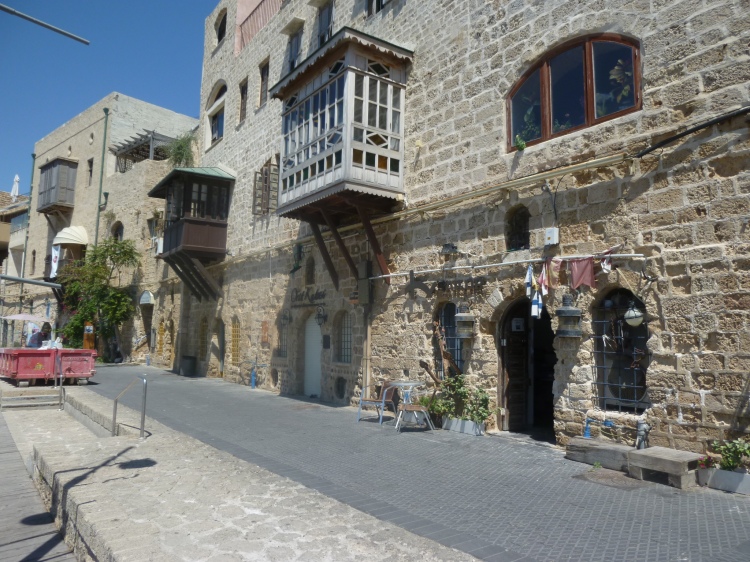
The Old City of Jaffa — it would have looked something like this when Ignatius visited in 1523
Now he was in the Holy Land he could imitate Jesus by visiting the same towns He did, and helping souls as He did. He was there for three weeks visiting the holy places. Juan Polanco—who was Ignatius’ secretary when he was General—tells us that in the Holy Land Iñigo developed a plan: “To remain in that land for his own greater profit as well as that of the infidel (ie. Muslims) preaching the Christian faith and doctrine to them.”[3]
He knew that this would not be easy, but he was ready to suffer as Christ did in order to join him in saving souls. However, he was told by the Franciscan superior — who had authority over Roman Catholics in the Holy Land — that the situation was too dangerous. At the time the Turks were the rulers of the Holy Land. Some pilgrims had been kidnapped, some killed and others held for ransom which severely depleted the financial resources of the Franciscan Friars. The Franciscan Provincial ordered Iñigo to leave and informed him that he had the power to excommunicate him if he did not go. Iñigo obediently departed having bowed to legitimate ecclesial authority. His desire to live in the Holy Land was frustrated but Iñigo was not defeated.
We know from Ignatius’ Autobiography that he desired to go the Mount Olivet a second time before he left Jerusalem. He did so without a guide, or permission:
After this, returning to where he was before, he was seized with a great longing to visit Mount Olivet again before he departed, since the Divine Will would not suffer him to remain in those holy places. On that mountain is a rock from which Our Lord ascended to heaven, on which even now His footprints are visible. And this is what he wished to see again. Therefore, without telling any one, and without a guide, although it was a dangerous thing to go without a Turkish guard, secretly withdrawing he went to Mount Olivet alone. As the guards would not allow him to enter, he gave them his knife. After great consolation in prayer he desired to go to Bethphage. When he reached that place, he thought that on Mount Olivet he had not noticed the position of the right foot of Our Lord and that of the left. He came a second time, and gave his scissors to the guards to allow him to enter. Afterward when at the monastery it was discovered he had gone without a guide, a great search was made for him. Coming down from Mount Olivet he met a girdled Christian, those who are bound to wear a girdle to distinguish them from the Mussulmans; this man, pretending to be very angry, threatened him with a large stick, and approaching, firmly grasped him by the arm. He allowed himself to be led, but the good man once he had hold of him did not let him go. In the meantime, as he was thus led along a captive, he was visited with great consolation, as he seemed to see Christ walking above him. And this continued until he reached the monastery.
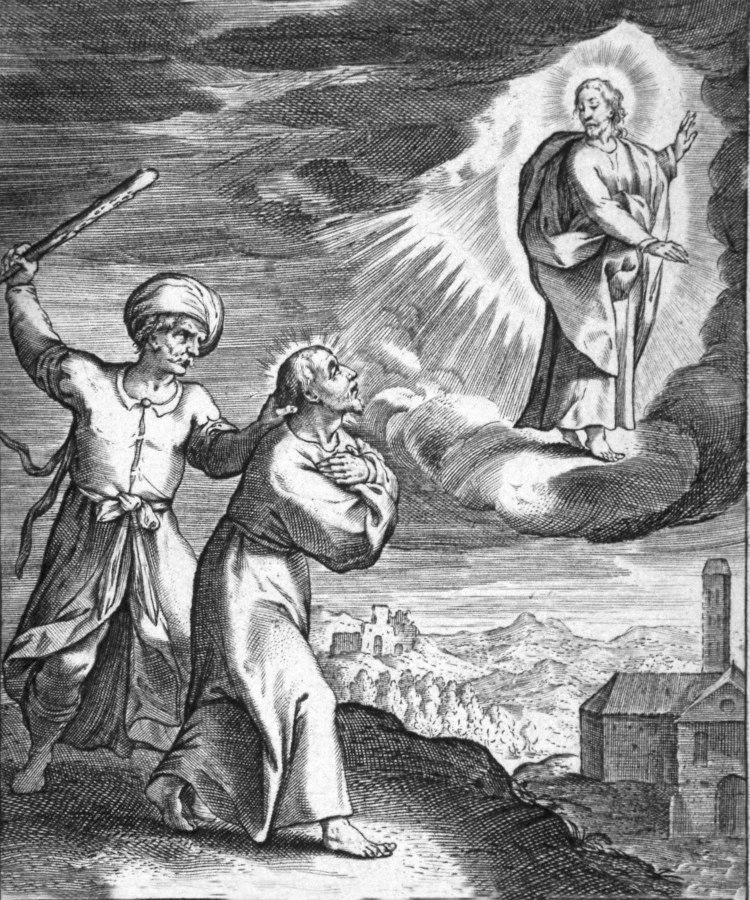
A servant of the Franciscans drags Ignatius back from chapel of Ascension

As Ignatius is expelled from the Holy Land, Christ appears to him (The Sacristy, Iglesia de San Pedro, Lima, Peru)

The building which houses the stone from which Jesus ascended
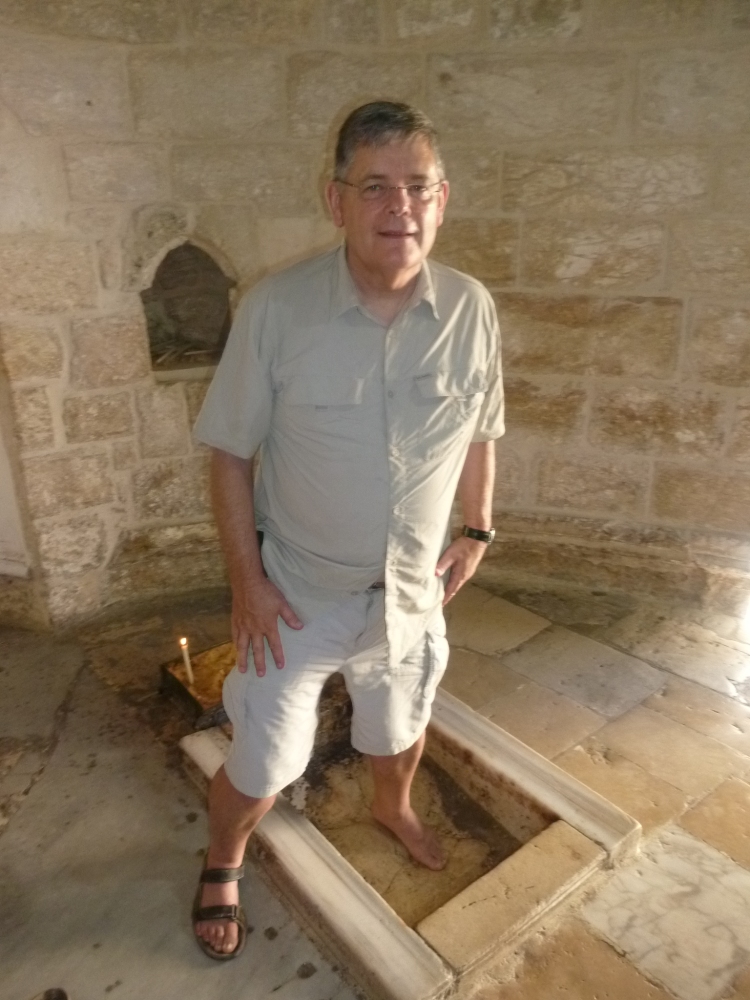
I too place my foot there
Apparently the same Muslim family that had possession of this holy site in Ignatius’ time still owns it today, and you still pay to get in.
Now that Inigo’s desire to remain in the Holy Land has been frustrated what is next?
We know that Ignatius then proceeded to get an excellent theological education at various universities in Spain (Barcelona, Alcala) and ten years later finished studies with a Master of Arts from the University of Paris — at that time the premiere university in Europe.
The First Companions vow to go to Jerusalem
In 1534, Ignatius and his six companions made a vow to go to Jerusalem or, should that be impossible, to offer their services to the Pope.
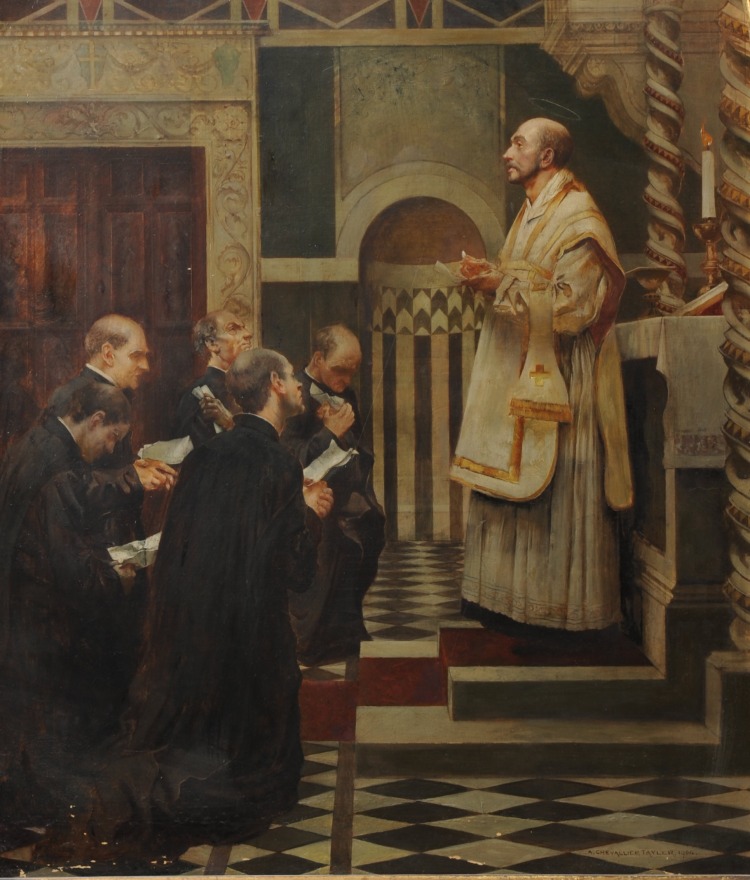
Ignatius and the First Companions make a vow to go to the Holy Land
In June 1537 — almost fourteen years after he first went to Jerusalem — Ignatius and his first companions planned to sail to the Holy Land, “but rumours of war and the threat from the Turks meant that no one dared sail to the East… They were disappointed especially as the new priests had hoped to celebrate their first Mass in the Holy Land.” [4] Instead they went to Rome where they presented a proposal for a new religious order, the Society of Jesus, to Pope Paul III in 1539, a proposal accepted by the Pope in 1540, over the objections of some cardinals. Ignatius was elected Superior General of the new order, and devoted the rest of his life to governance of what became known as the Jesuits. Michael Ivens comments:
Ignatius’ pristine desire to live as a pilgrim in the Holy Land would have died as an effective force had he not accepted first to be moved from the Holy Land and eventually to be persuaded by Pope Paul III that the wider world was a ‘true and good Jerusalem’, and thus to have his self-image as ‘pilgrim’ expanded into parameters utterly beyond the limits of his original desire.[5]
Ignatius could now say: “The whole world will be my Jerusalem!”
[1] Parmandanda R. Divarkar. Testament and Testimony: the memoirs of Ignatius of Loyola. India: Gujarat Sahitya Prakash. (2003), 20.
[2] Francis of Assisi probably visited Jerusalem and Bethlehem in 1219. We know that during his recovery Ignatius reflected on the lives of the saints he had been reading about, and began to ask himself: “What if I were to do what Saint Francis did, or to do what Saint Dominic did?” He actually did what St Francis did.
[3] Juan Alfonso de Polanco quoted by Gerald Coleman in Walking with Inigo: a commentary on the Autobiography of St Ignatius. India: Gujarat Sahitya Prakash. (2001), 90.
[4] Gerald Coleman. Walking with Inigo, 185.
[5] Michael Ivens. “Desire and Discernment.” The Way Supplement, (Summer, 1999), 41.
JERUSALEM TO NAZARETH
27 June 2016

The Pontifical Biblical Institute in Jerusalem
I left the Pontifical Biblical Institute just after 9.00am and walked over to King David Hotel with my luggage to catch a taxi to the Central bus terminus. I have spent the last week in Jerusalem exploring the Old City and other places, such as the Israel Museum and Yad Vashem, the very moving remembrance centre for the victims of the holocaust.
I took a bus from Jerusalem to Afula at 9.45 am, and another bus from Afula to Nazareth arriving at 12.30pm. I settled into the tranquil old-world ambiance of the Fauzi Azar Inn, a restored 18th-century Arab mansion, replete with painted ceilings and marble floors.

Reception at the Fauzi Azar Inn
At check-in I was issued with vouchers, a guide book, a map of the Jesus Trail, entrance tickets, luggage tags, etc. The Church of the Annunciation is with easy walking distance of Fauzi Azar Inn.
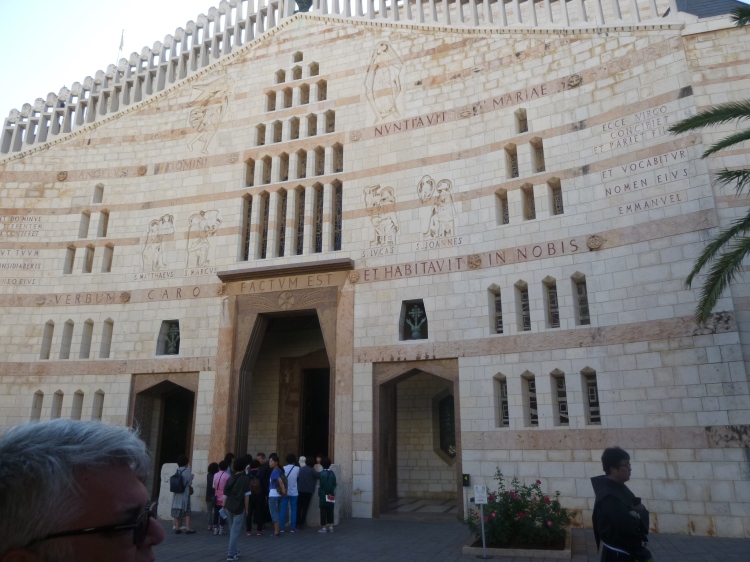
Church of the Annunciation in Nazareth
The Church of the Annunciation is the largest Christian church building in the Middle East. A Roman Catholic church, it marks the site where the Archangel Gabriel announced the future birth of Jesus to the Virgin Mary (Luke 1:26-31).
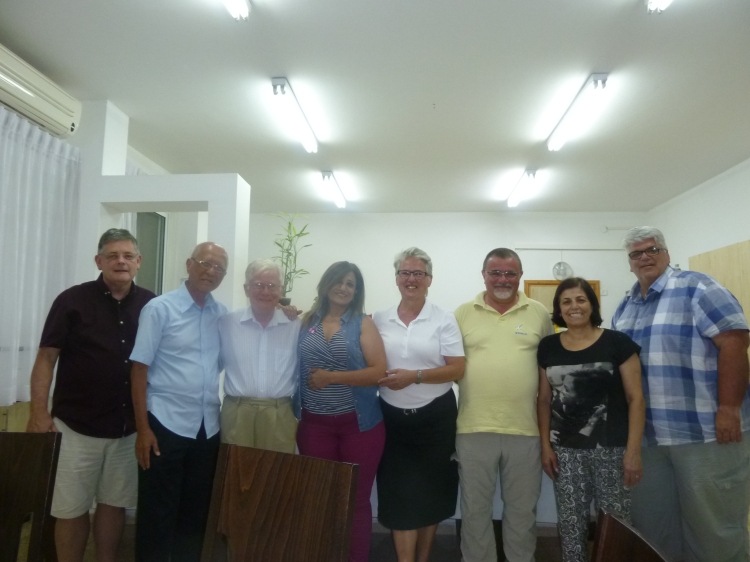
Abuna Faraj Pilgrim House
In the evening I had dinner at the Abuna Faraj Pilgrim House with Sr Martha Bertsch, the Austrian Sister who runs the house. If you want a wonderful place to stay in Nazareth, I recommend Abuna Faraj.
DAY 1: NAZARETH TO CANA
28 June 2016
I got up early, packed and ate a traditional Arabic breakfast of fresh pita bread, tomatoes, eggs and coffee. I filled my CamelBak hydration pack with 3 litres of water and took some lunch in my day pack. The rest of my luggage was transferred to the Cana Guest House where am staying this evening.
At 7.00 am I had an orientation session with Yafit, a Jesus Trail Tours staff member. During the orientation Yafi recommended that I download a free app called Trailze to my iPhone. I downloaded the Jesus Trail and it proved to be very helpful during the day’s walk. Once when I went off the route a claxon horn sounded and the app showed that I was 78 metres from the route. Once I was back on track a bell sounded. Very helpful.
I started my journey at 7.50 am — a little later than I am planning to begin walking on the other days — following the orange dots up the 406 steps that take pilgrims out of the old city. This was probably the hardest part of the day’s hike.
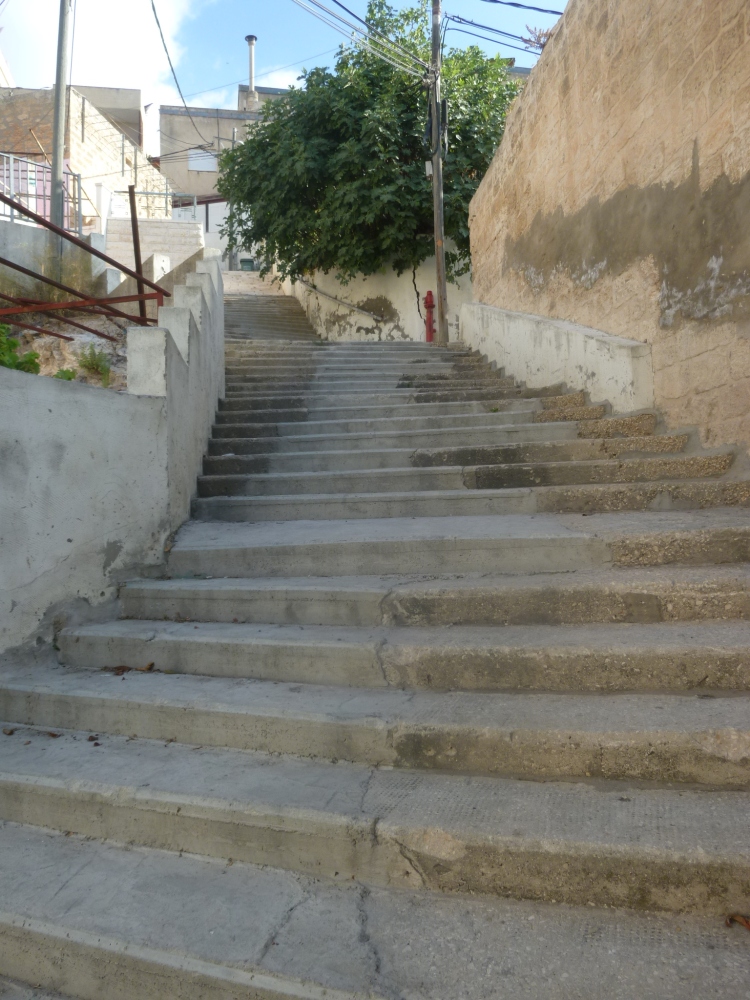
Some of the 406 steps up out of the Old City of Nazareth
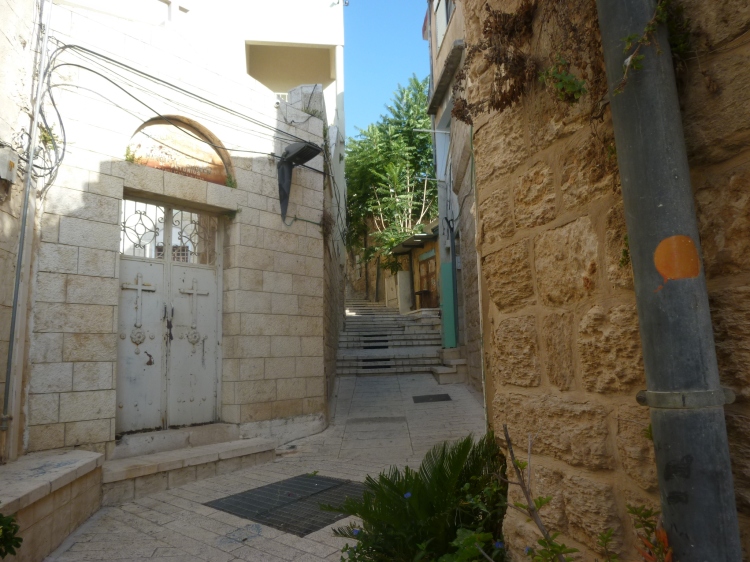
Orange dots show the way
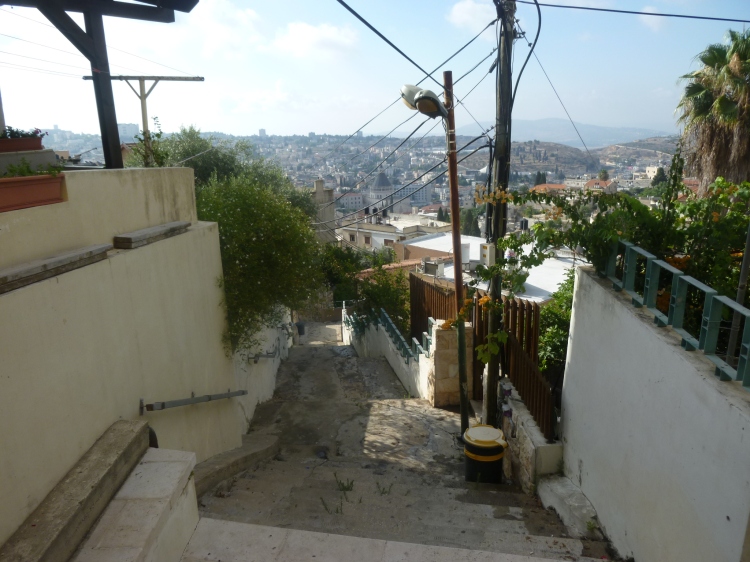
Looking back at the old city of Nazareth— the Church of the Assumption is in the middle
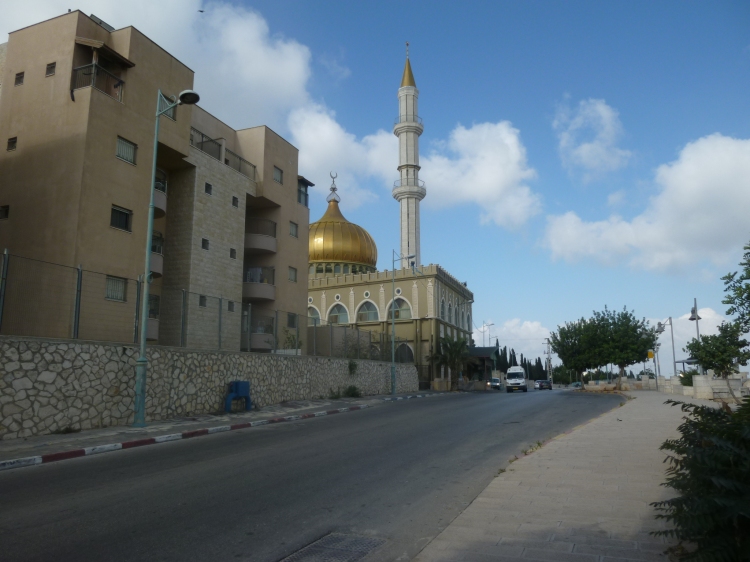
A Mosque at the top of the hill on the outskirts of Nazareth
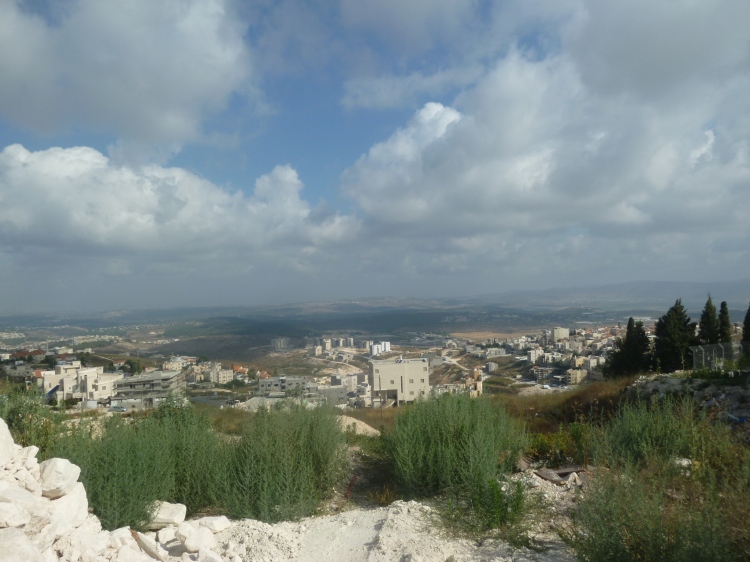
The morning was overcast — the weather was kind to me today
Once I got to the outskirts of the city I was walking through farm land.
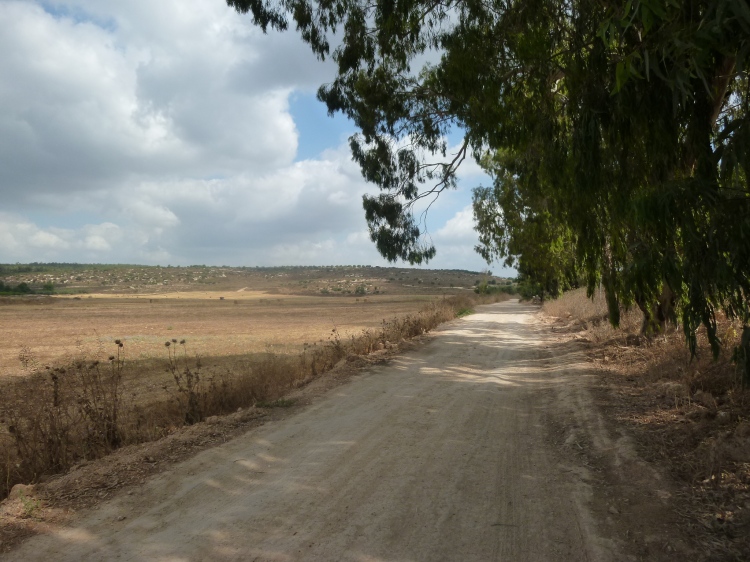
Farmlands and Eucalypts
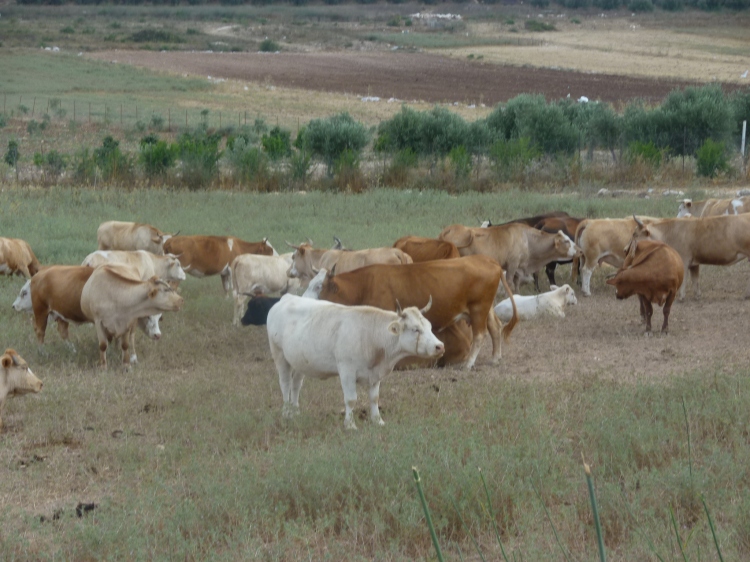
A scene which reminded me of Taranaki, my Province in New Zealand
The weather was overcast, and occasionally there was even a cool breeze. This change in the weather was most welcome. I am the only one walking the Jesus Trail and I had plenty of time for reflection and prayer.
The trail takes you though Zippori National Park
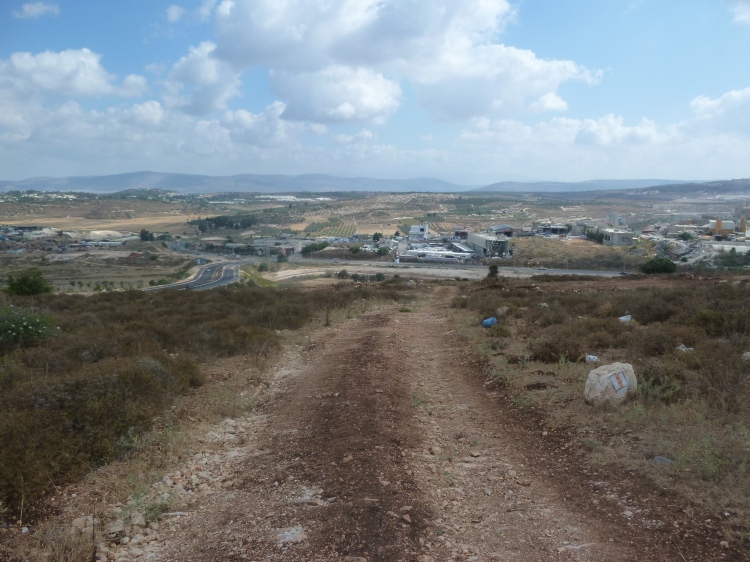
Orange and white stripes mark the Jesus Trail route
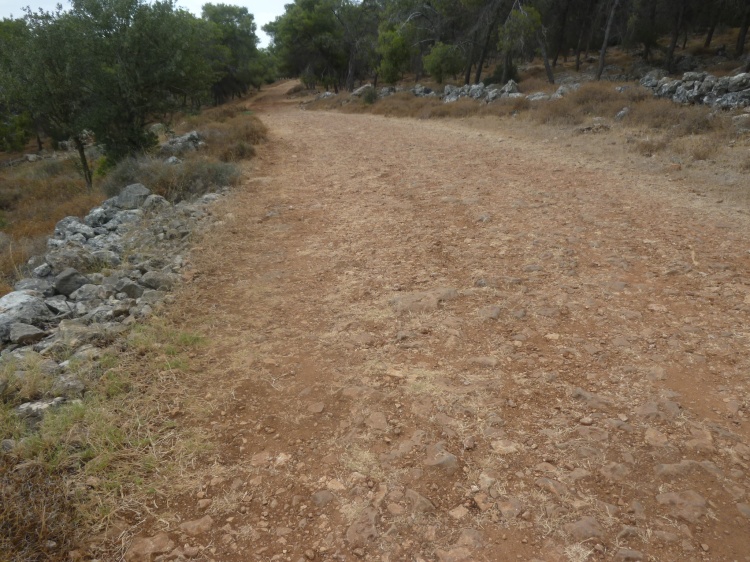
The track through Zeppori State Forest was rough and hard on my feet
Two weeks ago I visited the archeological ruins of Sepphoris, the main administrative city in the Galilee at the time of Jesus. There I viewed the exquisite Byzantine mosaics, took in the view from atop the Crusader fortress, and strolled through the ancient cistern system.
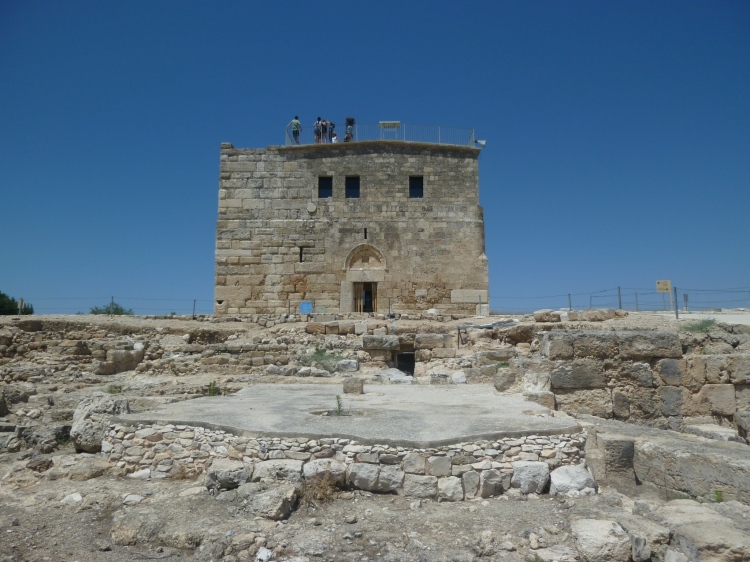
Crusader Castle at Sepphoris
Zippori (in Greek, Sepphoris) is an archeological site in Galilee where there is a Roman theatre, two early Christian churches, a Crusader fort, and many different mosaics dating from the third to the sixth century AD.

The site of Archeological excavations at Sepphoris
There are many beautiful mosaics at Sepphoris. It has the most extensive collection of ancient mosaic art in Israel, and perhaps the most famous was made in the 4th Century and is called the “Mona Lisa of Sepphoris”.
It is on the floor of the banquet hall of a Roman villa. The mosaic, shown below, is located in the central panel and portraits a beautiful woman – probably an illustration of the Roman Goddess Venus.

The Mona Lisa of Sepphoris
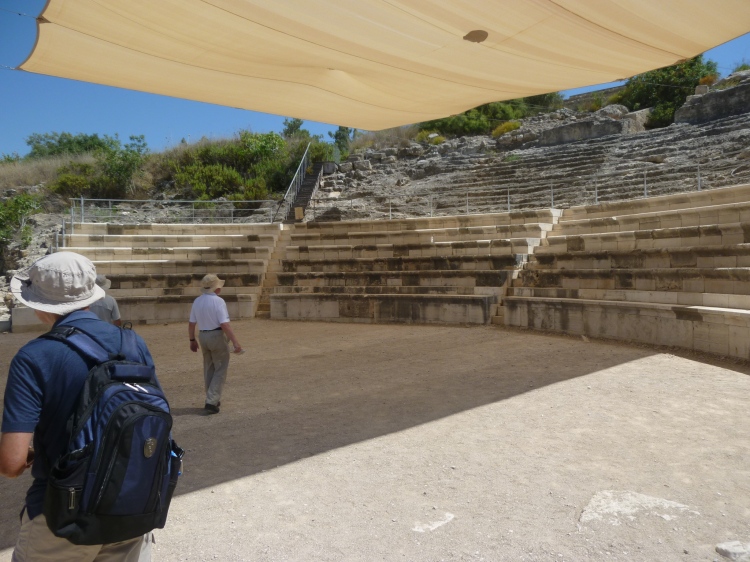
The Amphitheatre at Sepphoris
During Jesus’ youth the largest restoration project of his time took place at Zippori. Zippori is not far from Nazareth and there is a theory that Jesus may have worked with his father as a carpenter there. However, the city is not mentioned in the Gospels, but he probably visited the city, which was in walking distance of Nazareth.
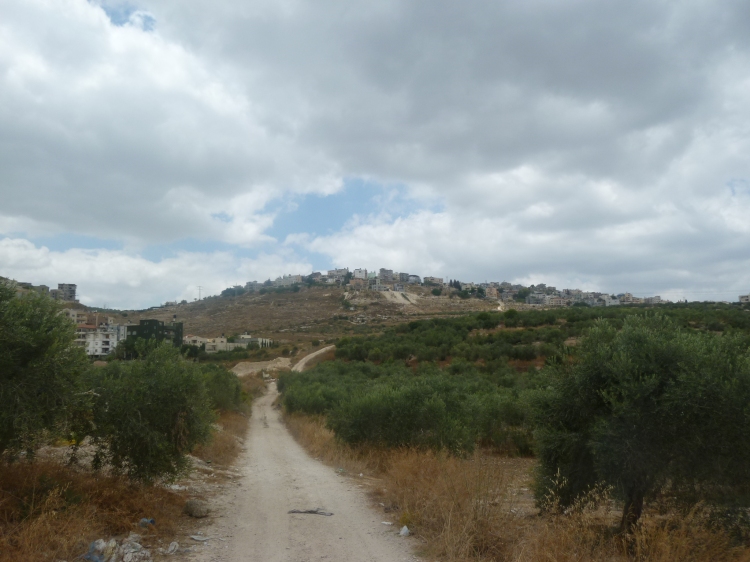
Looking back at the Muslim village of Mash’had
I walked through the small Muslim village of Mash’had and arrived at Cana, traditional site of Jesus’ first miracle, at 12.30pm.
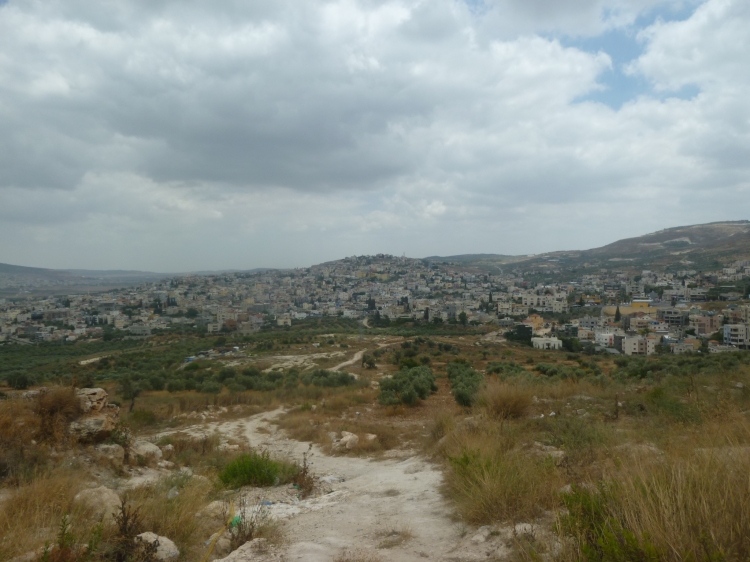
The track to Cana which is in the distance
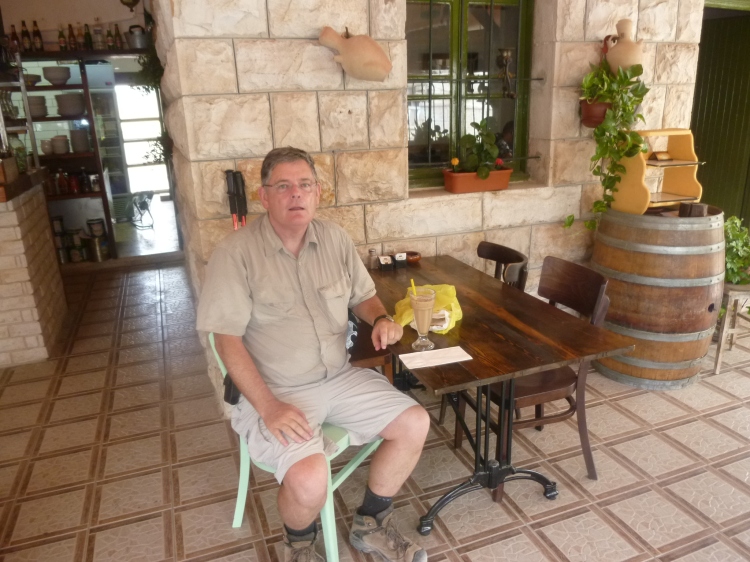
A very welcome iced coffee in Cana at the end of my day’s journey
I had a shower, hand-washed my clothes and took a rest before visiting the Sanctuary of Jesus’ First Miracle which commemorates Jesus’s turning water to wine.
John Chapter 2
On the third day there was a marriage at Cana in Galilee, and the mother of Jesus was there; Jesus also was invited to the marriage, with his disciples. When the wine failed, the mother of Jesus said to him, “They have no wine.” And Jesus said to her, “O woman, what have you to do with me? My hour has not yet come.” His mother said to the servants, “Do whatever he tells you.” 6 Now six stone jars were standing there, for the Jewish rites of purification, each holding twenty or thirty gallons. Jesus said to them, “Fill the jars with water.” And they filled them up to the brim. He said to them, “Now draw some out, and take it to the steward of the feast.” So they took it. When the steward of the feast tasted the water now become wine, and did not know where it came from (though the servants who had drawn the water knew), the steward of the feast called the bridegroom and said to him, “Every man serves the good wine first; and when men have drunk freely, then the poor wine; but you have kept the good wine until now.” This, the first of his signs, Jesus did at Cana in Galilee, and manifested his glory; and his disciples believed in him.
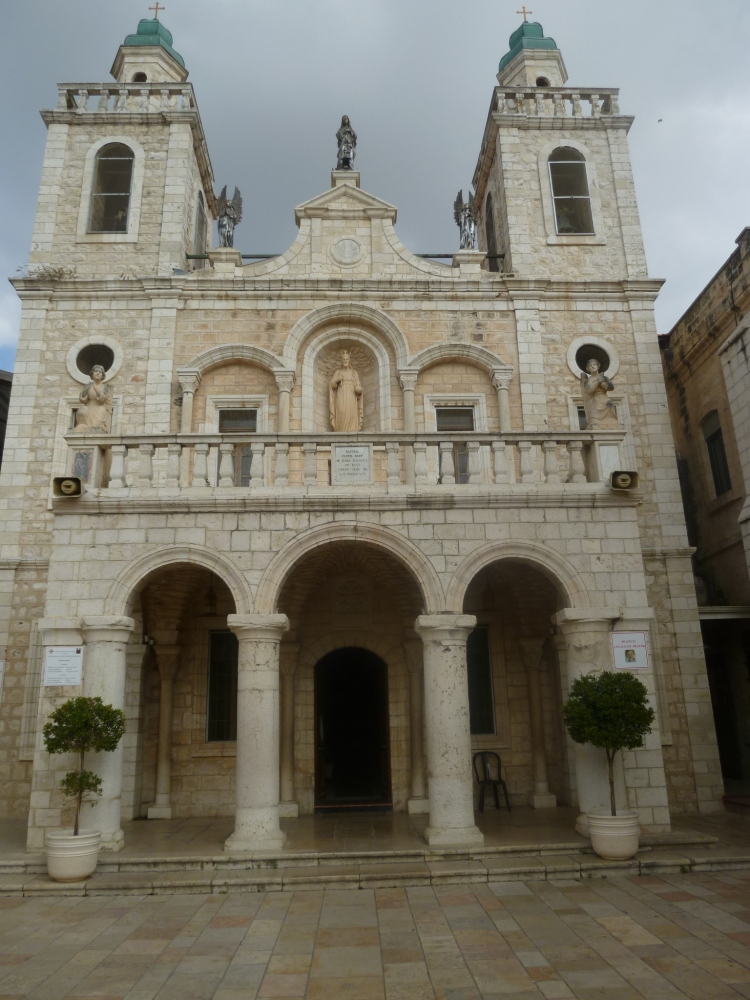
The Sanctuary of Jesus First Miracle which is just in front of the Cana Guest House
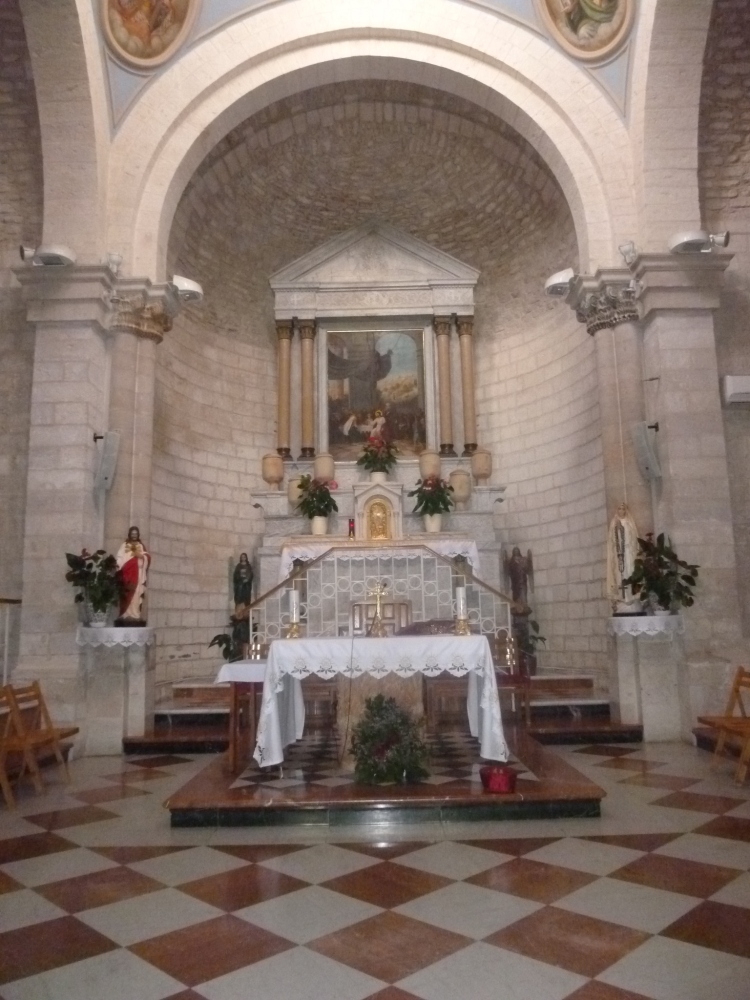
The interior of the Sanctuary of Jesus First Miracle

A stone water jar of the type used in Jesus’ time
At 7.00pm I ate a home-cooked meal with my hosts. It was very tasty.
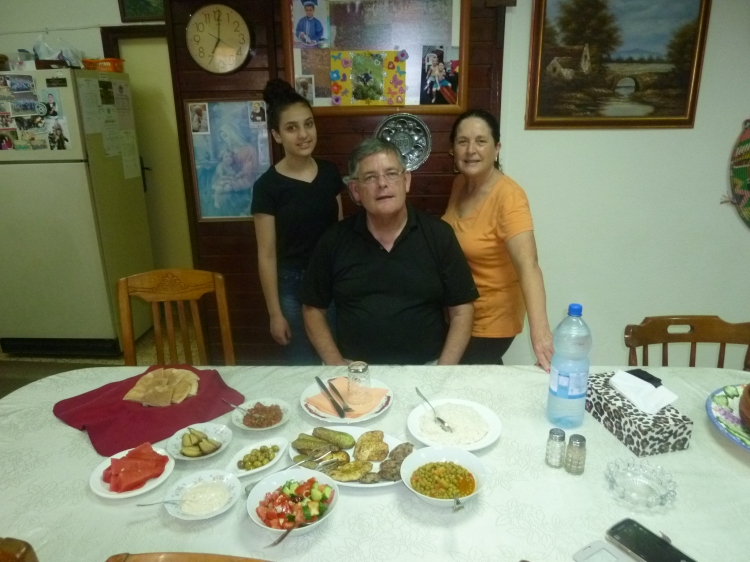
Nagham Billan, Michael and Suad Billan, Nagham’s grandmother and the owner of the Cana Guest House

Salman Billan, (Suad’s son), Michael and Suad Billan
29 June 2016
Suad and her husband made me a hearty breakfast at 7.00 am and some food for lunch today. I filled my Camelbak with 3 litres of cold water and left the Cana Guest House at 7.25 am to began the ascent out of Cana. It was already quite hot at that time, so because of the heat I walked slowly today and drank regularly. It wasn’t long before my shirt was drenched.

At the top there is a forest ridge with peaceful valley views.
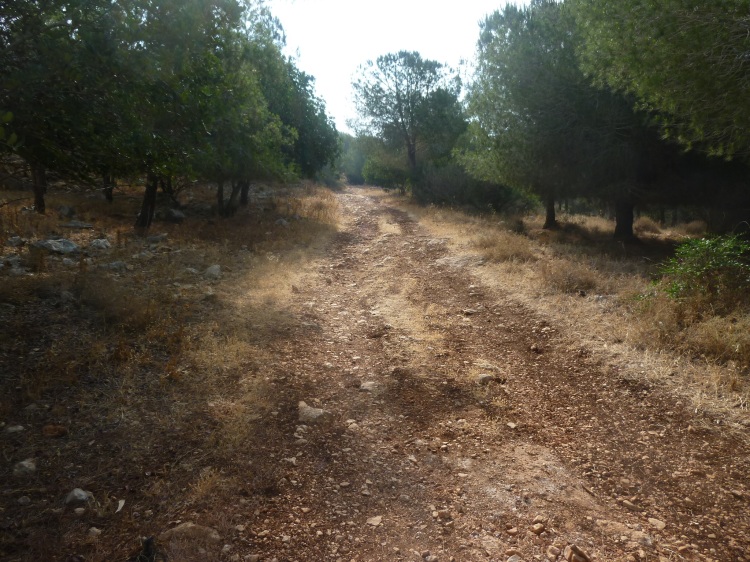
The track is rocky and uneven today
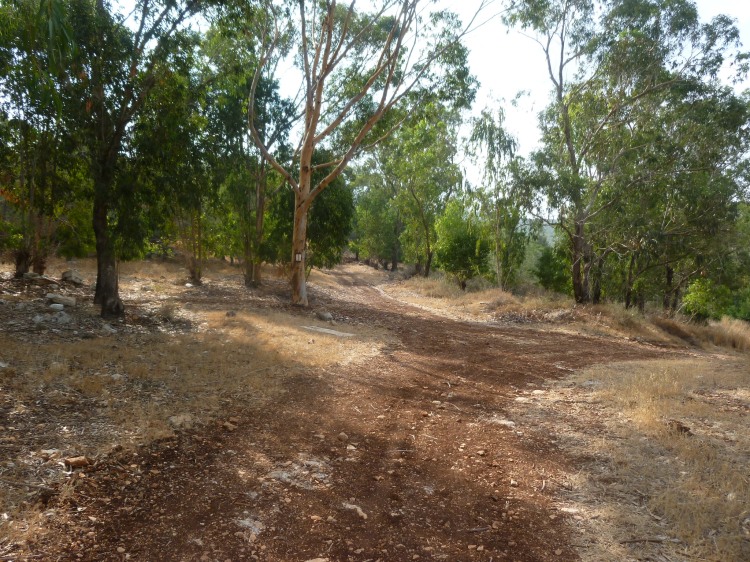
Which track to take?
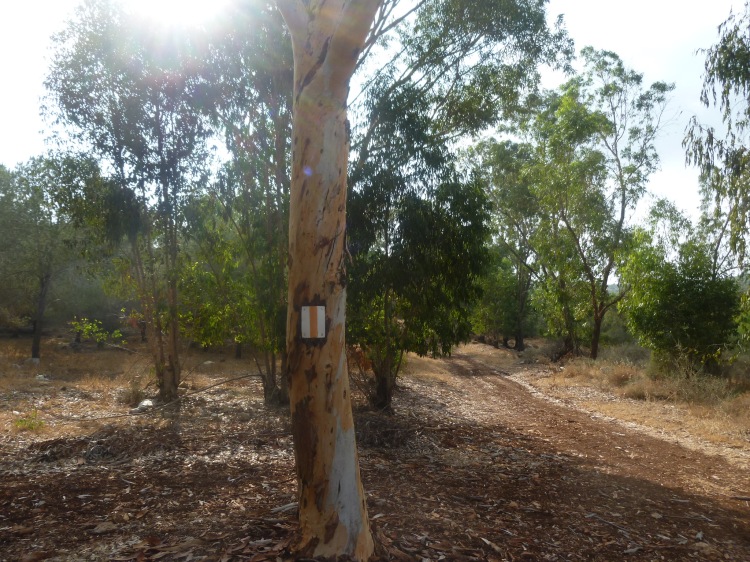
A welcome sign for the Jesus Trail
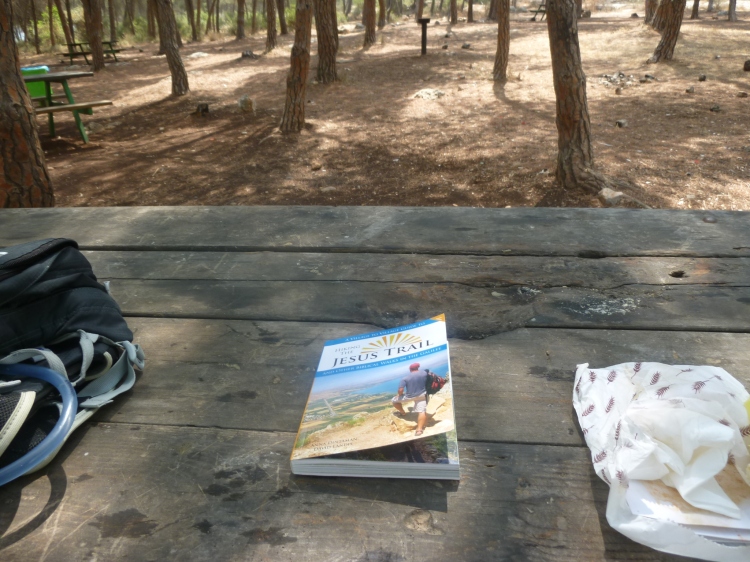
A picnic area where I stopped to have lunch, take off my boots and read the Jesus Trail guide book.
One of the blessings of being alone on the Jesus Trail has been the quiet and entering into the presence of God in the silence. I am reminded of the prophet Elijah’s experience:
(The angel said to Elijah), “Go out and stand on the mountain before the Lord, for the Lord is about to pass by.” Now there was a great wind, so strong that it was splitting mountains and breaking rocks in pieces before the Lord, but the Lord was not in the wind; and after the wind an earthquake, but the Lord was not in the earthquake; and after the earthquake a fire, but the Lord was not in the fire; and after the fire a sound of sheer silence. When Elijah heard it, he wrapped his face in his mantle and went out and stood at the entrance of the cave (1Kings 19:10-12).
On the trail I have become very aware of the silence and feel drawn to enter into it.
While the signs for the Jesus Trail are good, and the Guide Book well done, I was very glad of the Trailze app today which five times sounded a claxon that I had missed a turn. In the heat and the burning sun of the Middle East the last thing I needed was to be walking any extra distance.

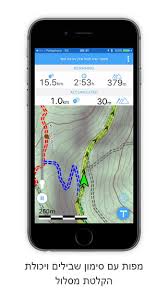
I am staying at the hotel at Kibbutz Lavi, one of few religious Jewish kibbutzim in Israel. This evening I enjoyed a kosher buffet in the dining room.

The kosher buffet in the dining room
DAY 3: KIBBUTZ LAVI TO MOSHAV ARBEL
30 June 2016

Kibbutz Lavi Hotel
After a Kosher breakfast at the Kibbutz Lavi Hotel, I checked out and began walking at 7.10am. I re-joined the Jesus Trail at 7.30am. The trail was very rough and rocky today.

Rocky terrain on the Jesus Trail

Early in themorning I was greeted by sunflowers inn the fields
I crossed agricultural fields and began to climb the Horns of Hattin — a double peaked volcanic formation that resemble the horns of a bull.

The Sea of Galilee can be seen from the Horns of Hattin. Mount Arbel is on the right.
The view from the top was worth the climb. I relished my first glimpse of the Sea of Galilee and the sweeping views into Arbel Valley.
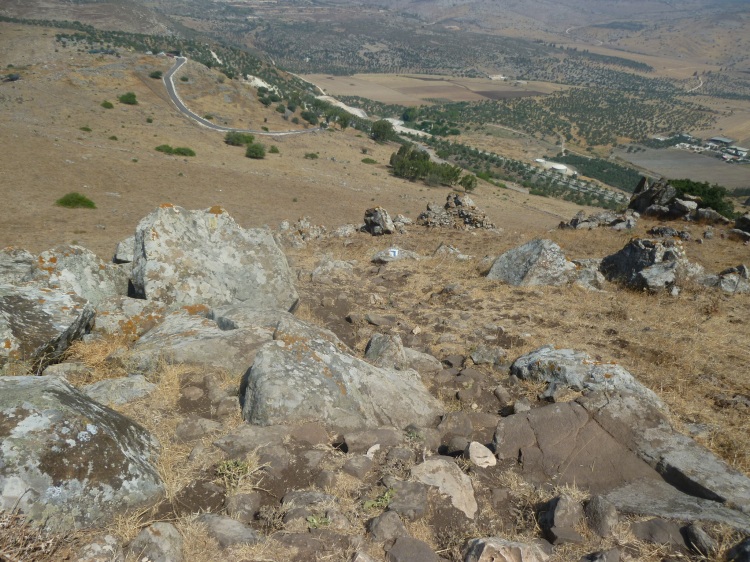
The steep descent from the Horns of Hattin

Looking back at the Horns of Hattin where I have just descended
The route down was very difficult and steep. I am so pleased that a purchased two walking poles from an Arab shopkeeper in the Old City of Jerusalem. They really helped coming down.
In 1187 the plains of Hattin was the site of the decisive battle between Saladin’s forces and the Crusaders. Saladin wrested control of Palestine from the Crusaders, who had conquered it 88 years earlier.
The Battle of Hattin took place on July 4, 1187, between 20,000 Crusaders under the command of Guy of Luisignan and 30,000 men under the command of the Kurdish Sultan Salah ad-Din, known in the West as Saladin.
The Muslim armies under Saladin captured or killed the vast majority of the Crusader forces, and removed their capability to wage war. As a direct result of this battle, Muslims once again became the eminent military power in the Holy Land, re-conquering Jerusalem and several other Crusader-held cities.
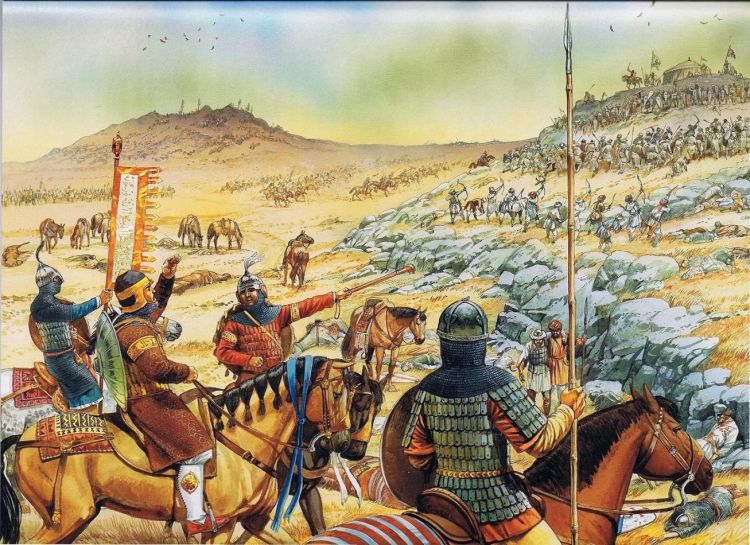
The forces of Saladin and the Crusaders do battle under the Horns of Hattin
After lunch, I continued on the trail through Arbel Valley past ancient olive groves and the ruins of Hattin village. I after a long hike I began a steep ascent out of the valley to Moshav Arbel. The day was very hot, and the climb up from the track to Moshav Arbel was particularly exhausting in the sun.
I am staying with Mr and Mrs Konwitz in one of their wooden cabins. I ate a very tasty dinner cooked by Mrs Konwitz. She studied philosophy at university and then became a teacher and later a school principal. She is a devotee of Jean-Paul Sartre and over a plate of meatballs, rice, potatoes and salads we discussed whether the human person really is free.
Ben Konwitz, my Jewish host at Moshav Arbel, pursues archeology as a hobby. He suggested to me in a conversation this afternoon that the Transfiguration happened on the Horns of Hattin.
Jesus took with him Peter and John and James, and went up on the mountain to pray. And while he was praying, the appearance of his face changed, and his clothes became dazzling white. Suddenly they saw two men, Moses and Elijah, talking to him. They appeared in glory and were speaking of his departure, which he was about to accomplish at Jerusalem. Now Peter and his companions were weighed down with sleep; but since they had stayed awake, they saw his glory and the two men who stood with him. Just as they were leaving him, Peter said to Jesus, “Master, it is good for us to be here; let us make three dwellings, one for you, one for Moses, and one for Elijah ”—not knowing what he said. While he was saying this, a cloud came and overshadowed them; and they were terrified as they entered the cloud. Then from the cloud came a voice that said, “This is my Son, my Chosen; listen to him!” When the voice had spoken, Jesus was found alone. And they kept silent and in those days told no one any of the things they had seen (Luke 9:28-36).
We don’t know where Jesus’ Transfiguration occurred — some suggest Mount Tabor — but my experience on the top of the Horns of Hattin is that it is a “thin” place where you seem to get a glimpse of the Holy. Others have suggested that that Jesus delivered the Sermon on the Mount there.
DAY 4: MOSHAV ARBEL TO TABGHA
1 July 2016
I left Arbel at 7.40am and, on my way up to Mount Arbel, I spoke with an Israeli farmer.
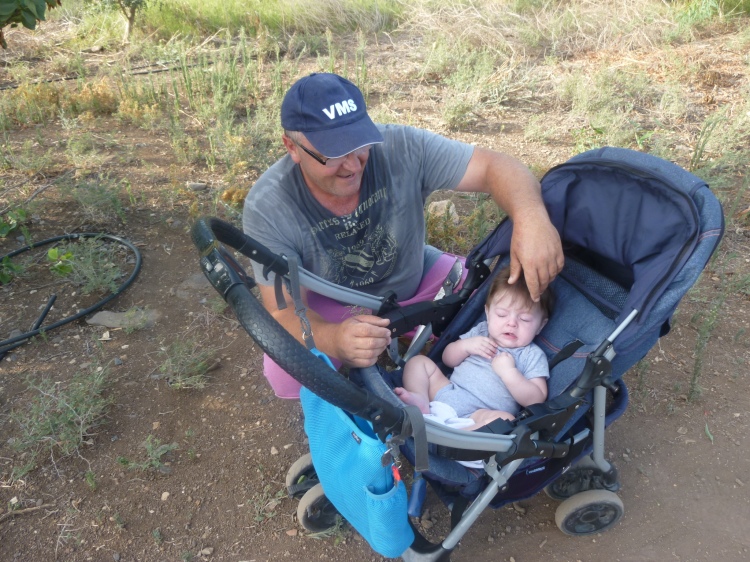
An Israeli farmer proudly showing me his son
He showed me how to get to the ruins of an ancient synagogue which stands amid the remnants of an ancient Jewish village. Ben Konwitz is convinced that if Jesus was coming from Nazareth to Capernaum he would have attended that synagogue.

The ruins of an ancient synaogue at Arbel
I walked up the Arbel Cliffs through the National Park.
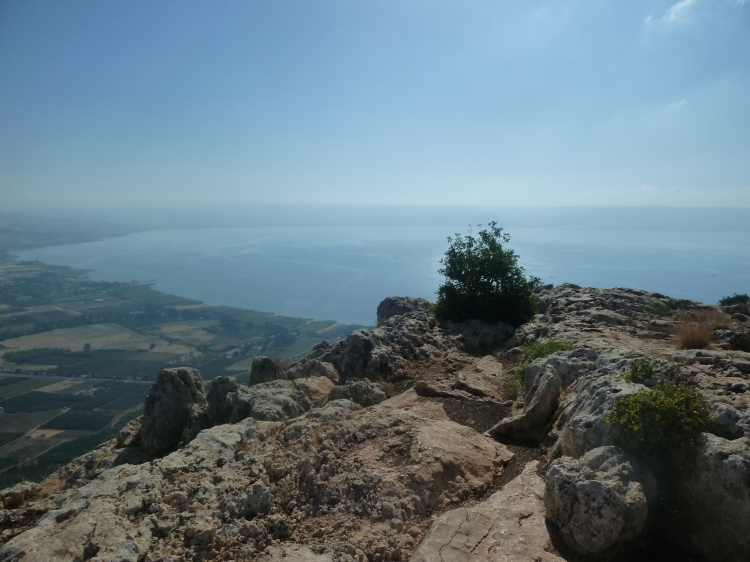
The Sea of Galilee from the top of Mount Arbel
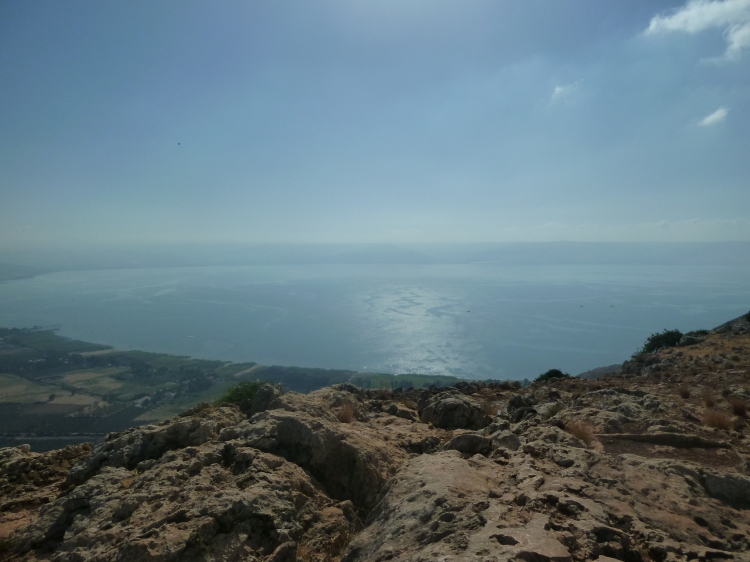
Another view of the Sea of Galilee from Mt Arbel
After about ten minutes at the top I began to carefully descend the steep trail down Mount Arbel, passing ancient cliff dwellings and caves.
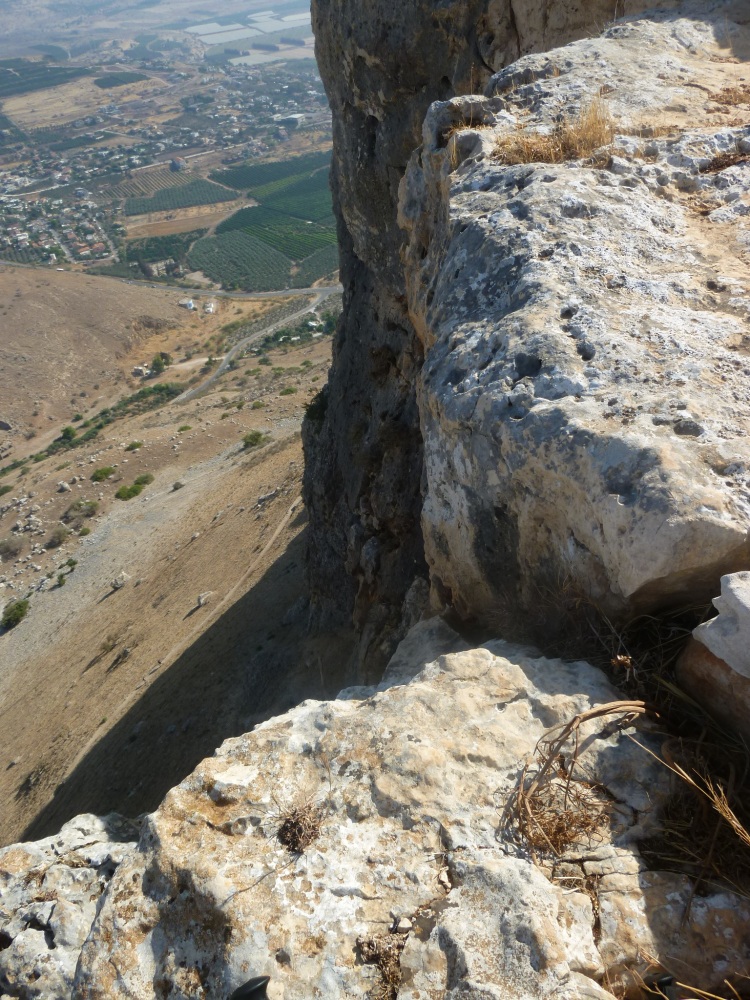
It’s a long way down..
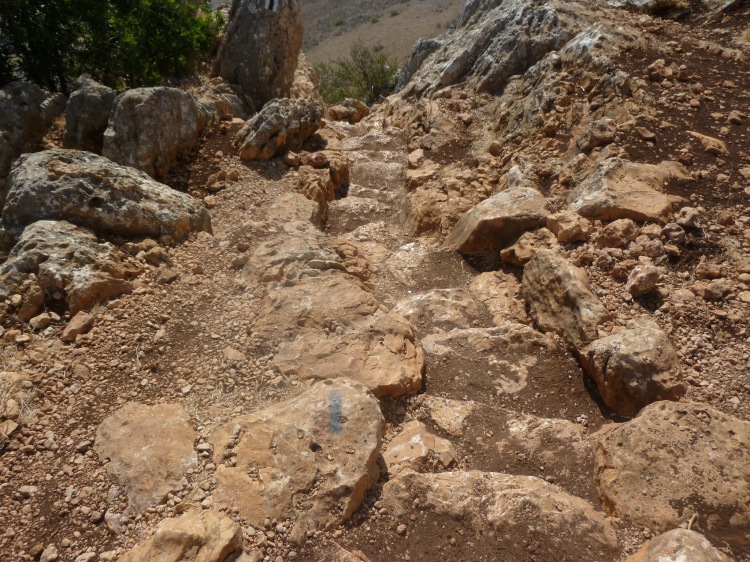
Now to go down…
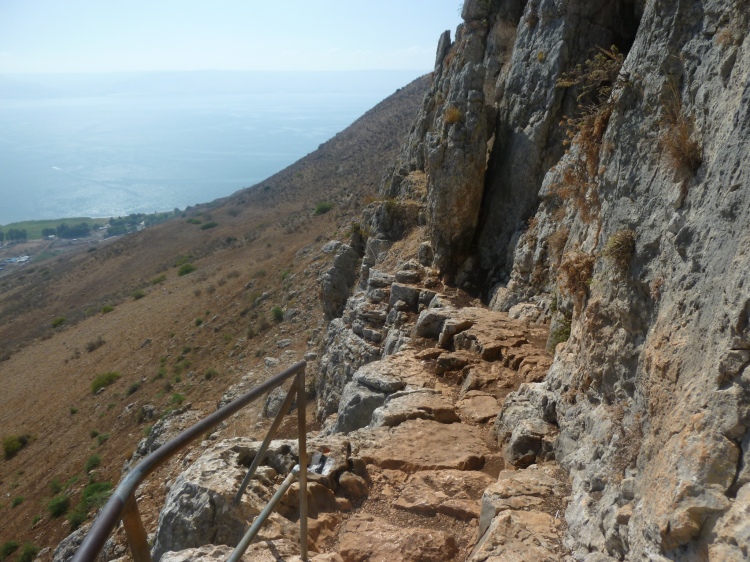
Occasional railings help
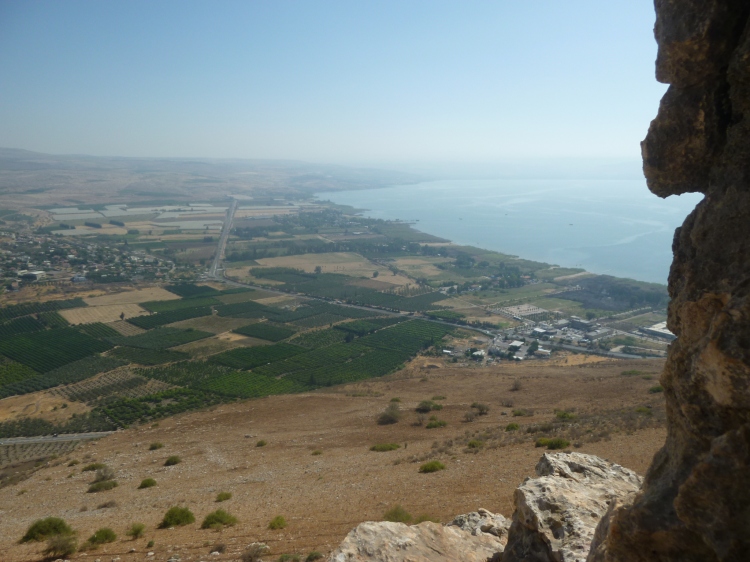
The view from inside a cave on the way down Mount Arbel

Caves provide some shelter from the searing heat
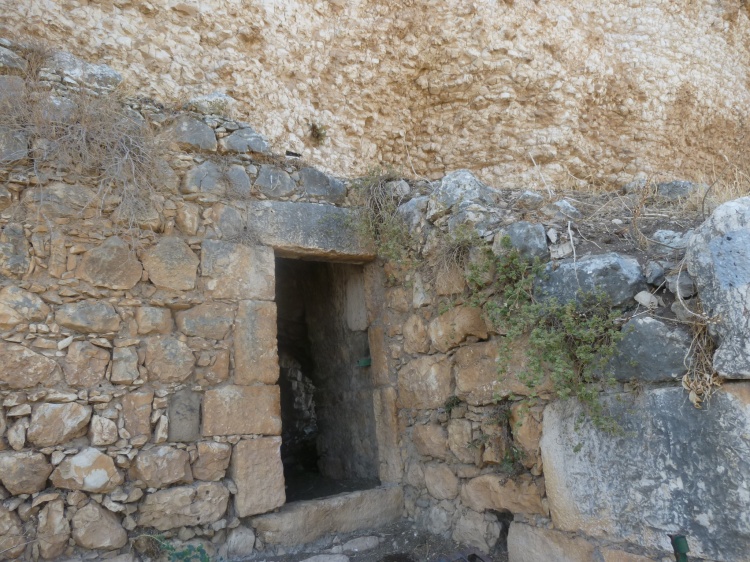
A cave in the mountain in a carved door
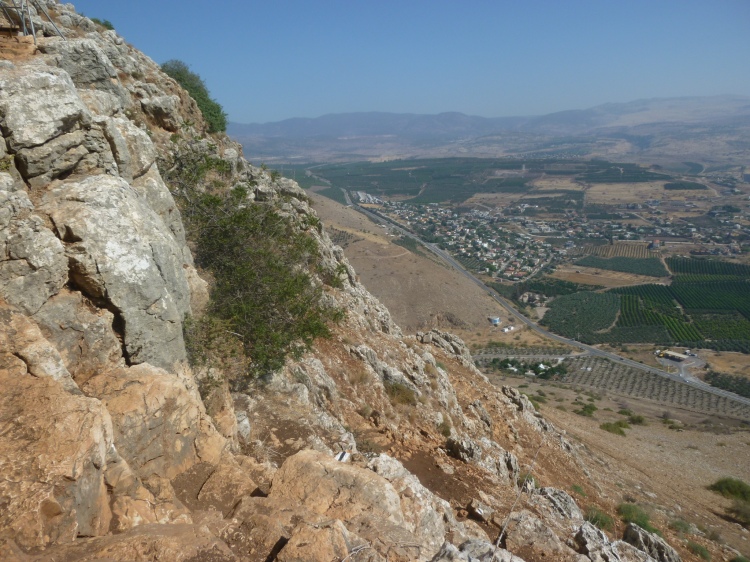
Not a difficult climb down, but potentially dangerous
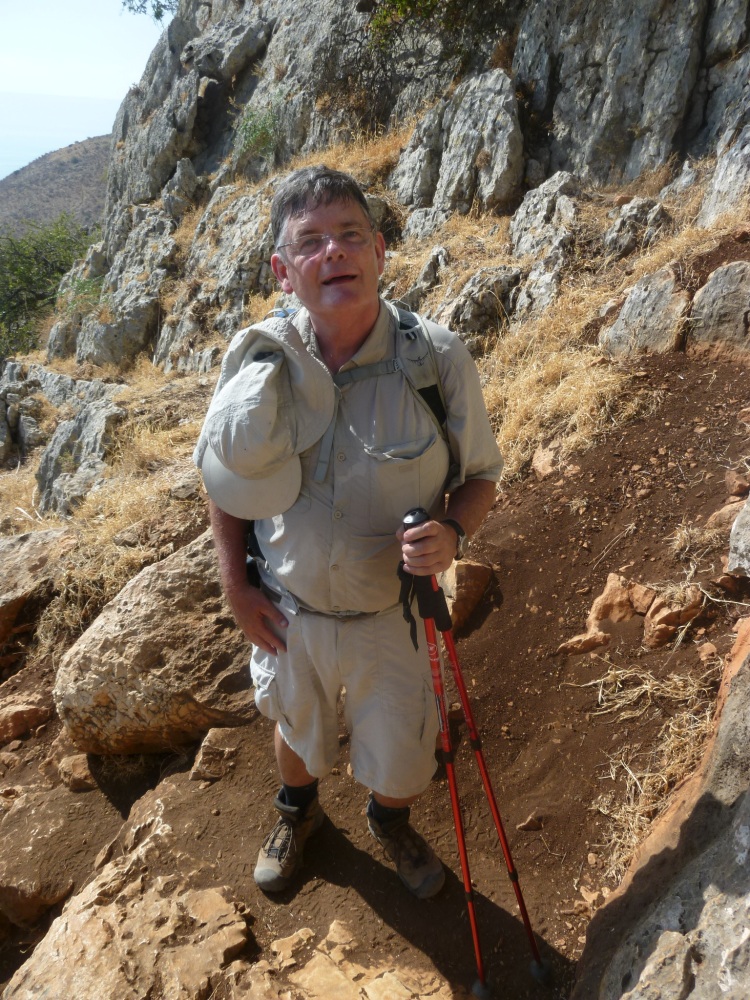
An Israeli man too my photo on the way down — note the sunhat and walking poles
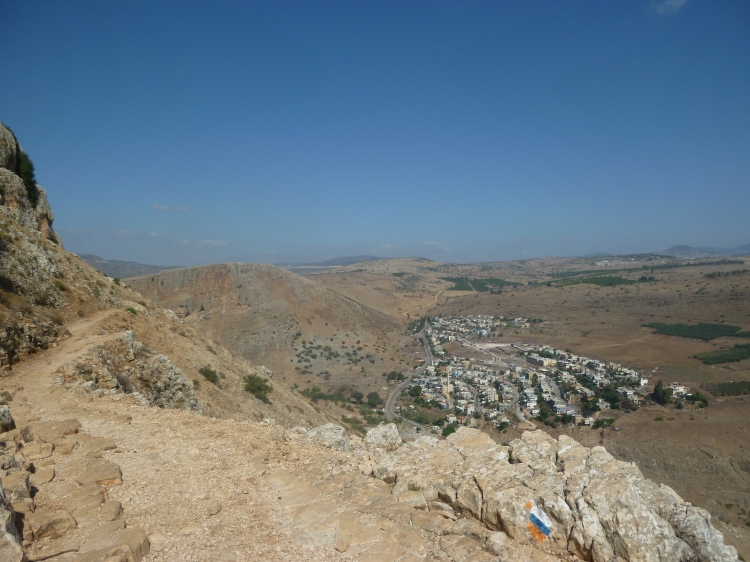
An easier par of the track (note the Jesus Trail markers)
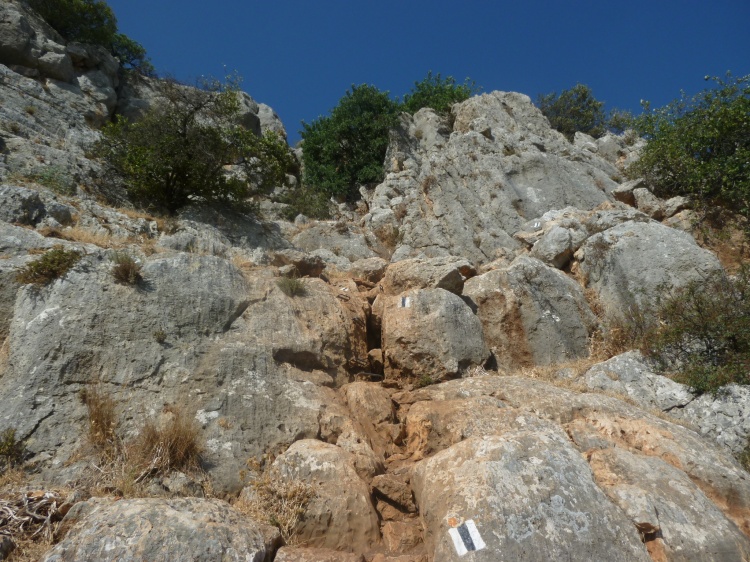
Looking back up Mount Arbel
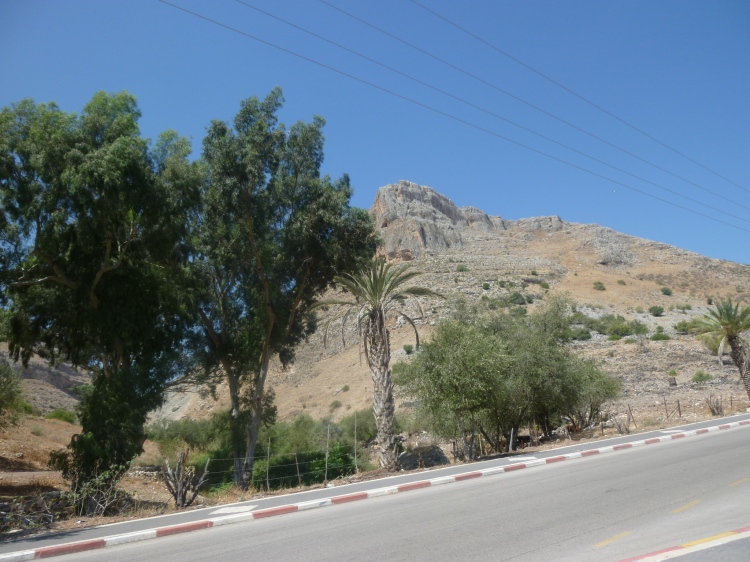
Looking back at the mountain I have just descended from Wadi Hamam
At Wadi Hamam I stopped for a drink before continuing on to Tabgha via rolling agricultural land.
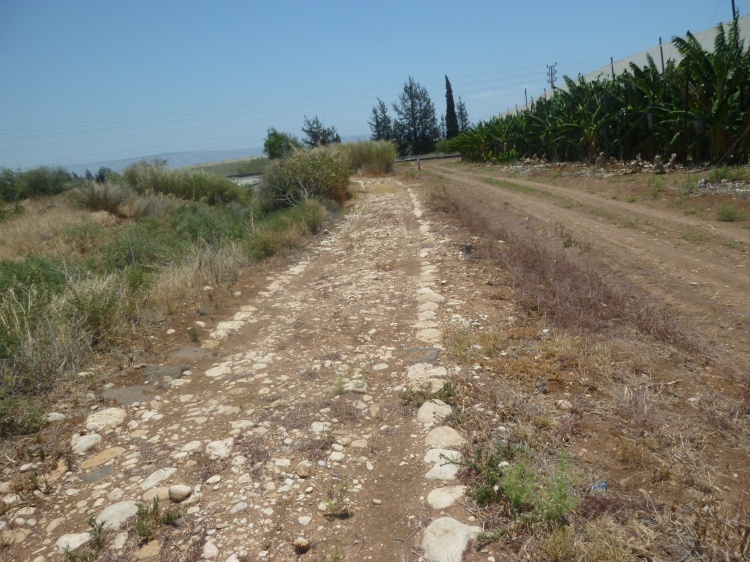
Part of the trail today was on a Roman road
It was just after 2.00pm that I arrived in Tabgha. It is traditionally accepted as the place of the multiplication of the loaves and fishes (Mark 6:30-46).
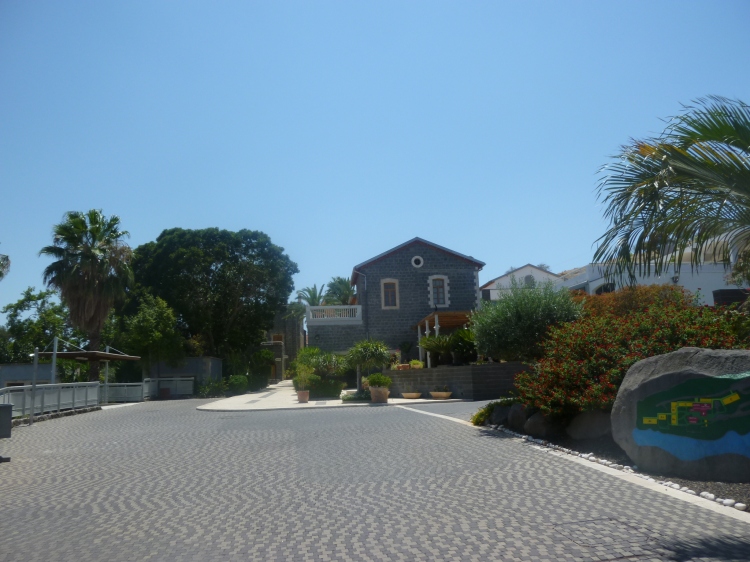
I will stay this evening here at the Pilgerhaus Tabgha
The Elevation Profile below shows the descent from Nazareth to Capernaum. Tabgha is below sea level. Tomorrow I will walk to the remaining 3 kilometres from Tabgha to Capernaum.
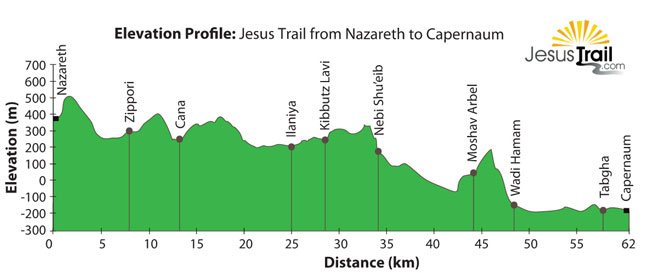
WOULD I RECOMMEND THE JESUS TRAIL TO OTHERS?
When I first read about this four-day walking pilgrimage, it didn’t seem so difficult. The distances were shorter than on the Camino Frances which I walked in May-June 2011, and also on the Ignatian Camino which I walked with a group in September-October, 2013. One memorable day on the Ignatian Camino, our group walked over 41 km (almost a marathon). However the terrain is much tougher on the Jesus Trail than either the Camino Frances or the Ignatian Camino. The distances are about right given the terrain. And the heat on the Middle East in summer is, frankly, dangerous. I would not recommend that people walk this in summer. But if you want a sense of the places where Jesus walked and the geography that he saw, then this is a wonderful experience. Early spring would be ideal, but remember, this is a difficult trail.
TABGHA TO CAPERNAUM
2 July 2016
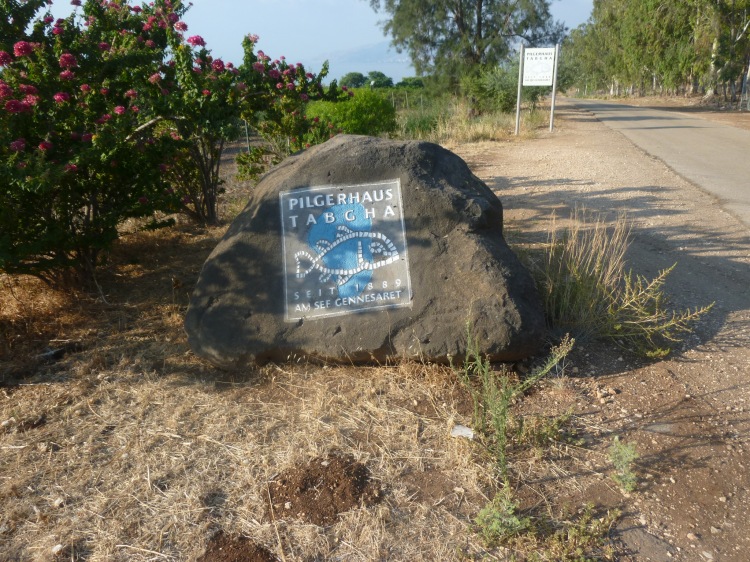
Pilgerhaus Tabgha
I got up early this morning to walk the last 3 kilometres from Tabgha to Capernaum. It was 5.40 am when I left the Pilgerhaus Tabgha and I arrived in Capernaum at 6.20 am. It was easy walking on the paved footpath, and cool at that time of the day. I imagined Jesus walking early in the morning by the lake and praying, as I was.
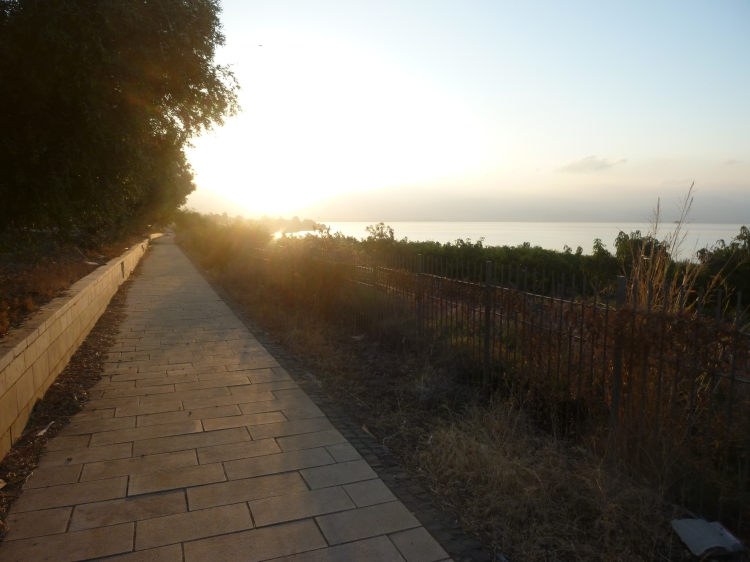
he path was paved today, unlike yesterday
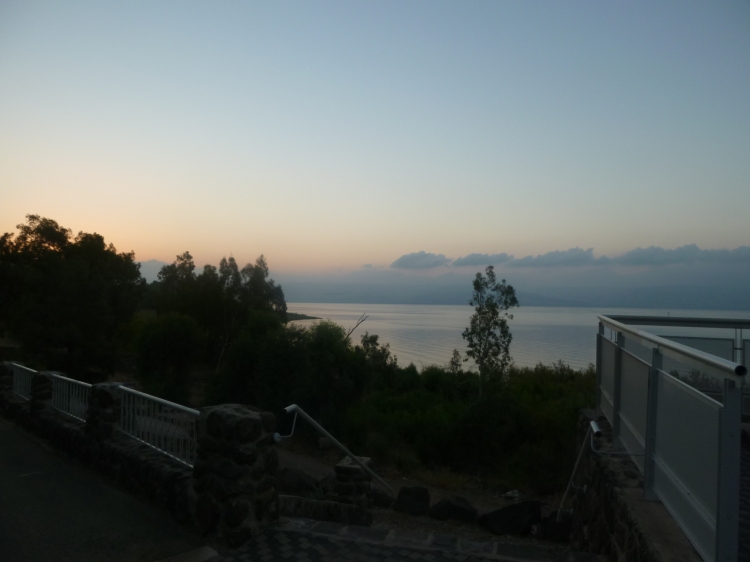
Early morning on the Sea of Galilee

A fisherman on the Sea of Gililee
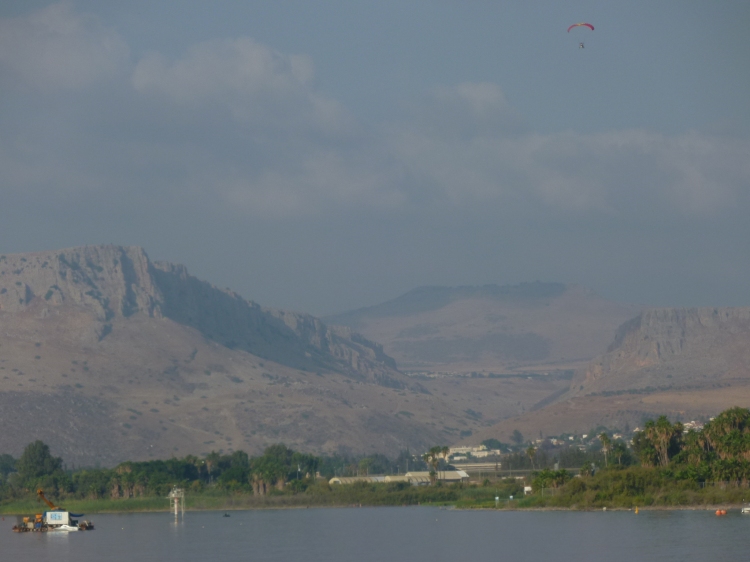
Mount Arbel with the Horns of Hattin behind
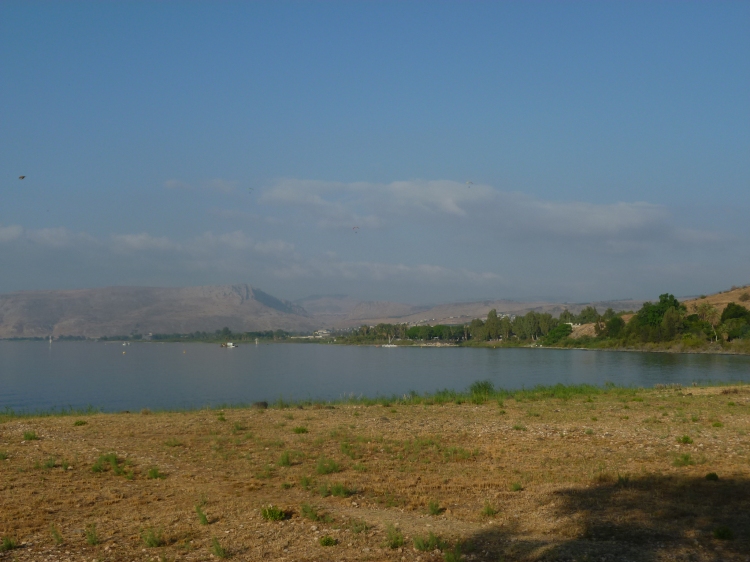
Another view of Mount Arbel across the lake
Today is the Sabbath, so no buses will be travelling until after sundown. This evening I will take a bus from Tiberias, which is on the other side of the lake, to Jerusalem. Check-out at Pilgerhaus Tabgha is usually at 11.00am, but the manager, Gabriel, has kindly allowed me to stay until 4.00pm when I will take a taxi to Tiberias. It is very hot and I am avoiding venturing out in the heat of the day. When I do go outside, I wonder how I walked for four days in this weather.
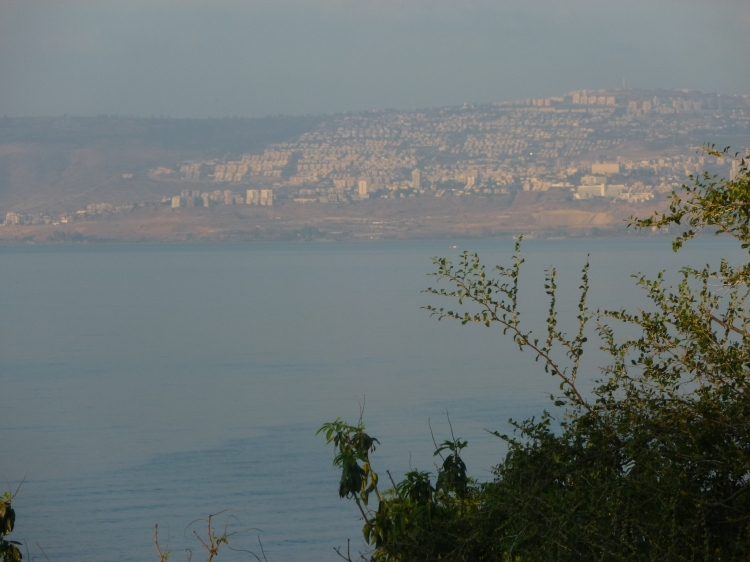
Tiberias on the other side of the lake
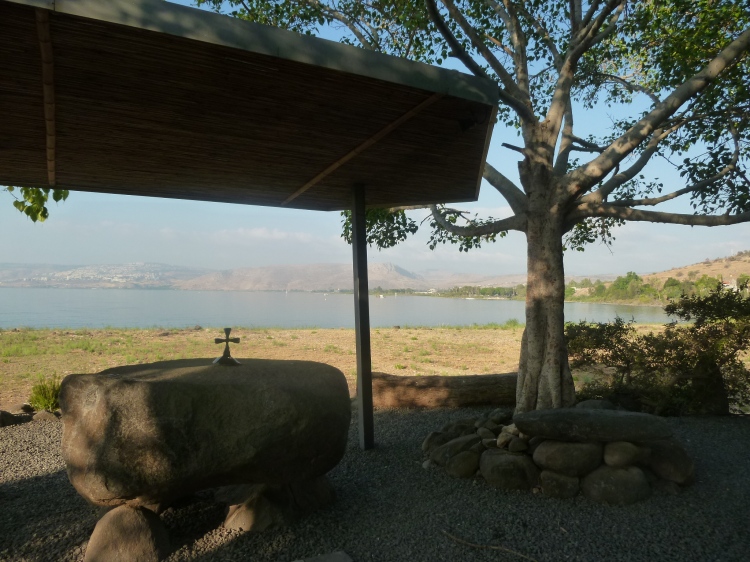
A stone altar at Tabgha
SOME REFERENCES TO CAPERNAUM IN THE GOSPELS
Then he went down to Capernaum, a town in Galilee, and on the Sabbath he taught the people.They were astonished at His teaching, because His message had authority.… (Luke 4: 31-32)
Leaving Nazareth, He went and lived in Capernaum, which is by the sea in the region of Zebulun and Naphtali (Matthew 4:13)
Then Jesus and His companions went to Capernaum, and as soon as the Sabbath began, Jesus entered the synagogue and began to teach (Mark 1: 21).
Jesus said to them, “Surely you will quote this proverb to Me: ‘Physician heal yourself! Do here in Your hometown what we have heard that You did in Capernaum’” (Luke 4:23).
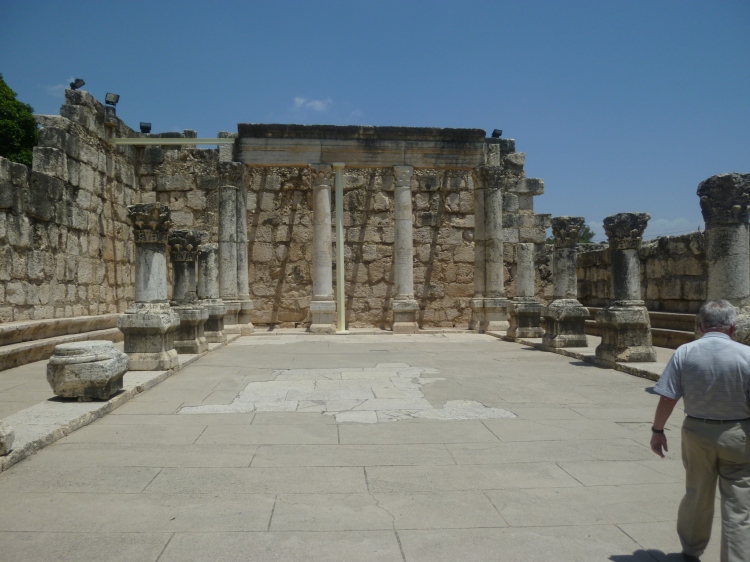
The ruins of an ancient synagogue at Capernaum
The Pilgerhaus is near the Benedictine Monastery in Tabgha. In the restored church there is a startling mosaic of a peacock. Early Christians adopted the symbol of the peacock to represent immortality. This came from an ancient legend that the flesh of the peacock did not decay. It is also associated with the resurrection of Christ because it sheds its old feathers every year and grows newer, brighter ones each year.
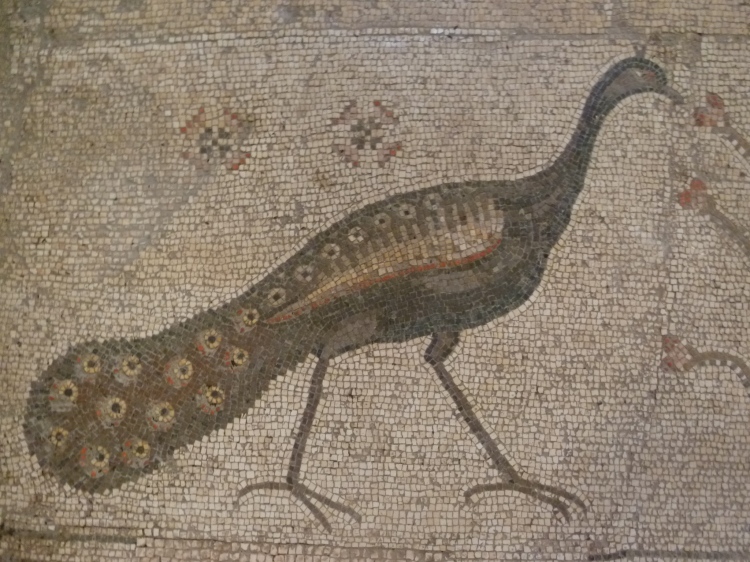
Peacock Mosaic — symbol of Jesus
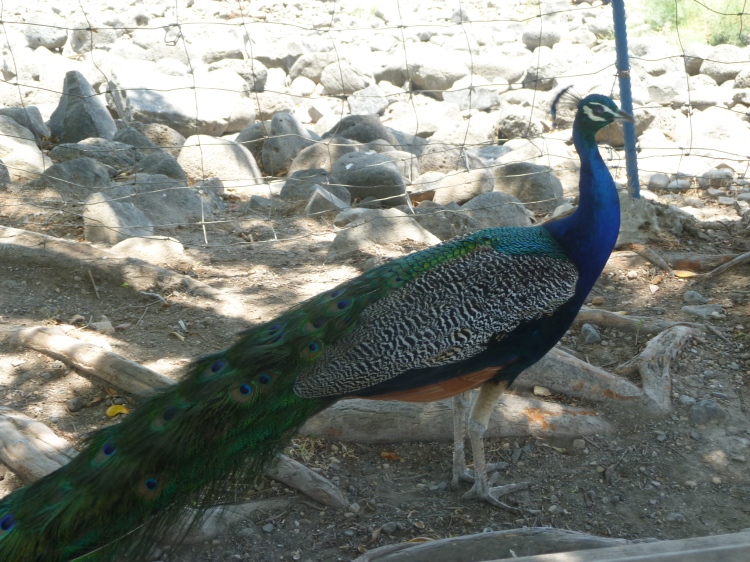
And there are peacocks walking around Capernaum and Tabgha
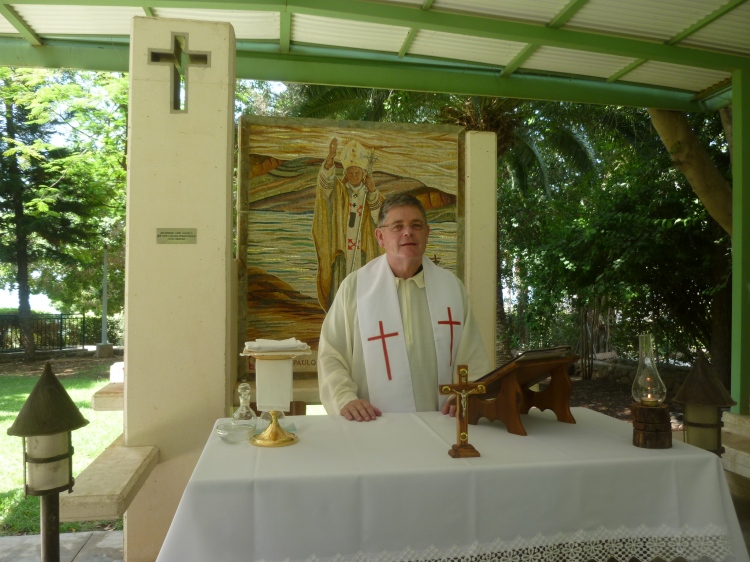
I was blessed to be able to Mass by the Sea of Galilee

Sea of Galilee
One of the last things I did before I left Tabgha was to go for a swim. The water was tepid, but it was nice to have a dip. I feel at home in this place.